Summer IT schools in Yakutia: how it is done
Good afternoon friends! Today I will tell you how we participated in the organization of 2-year-old IT schools in the Republic of Sakha (Yakutia) and what came of it. Welcome to cat.
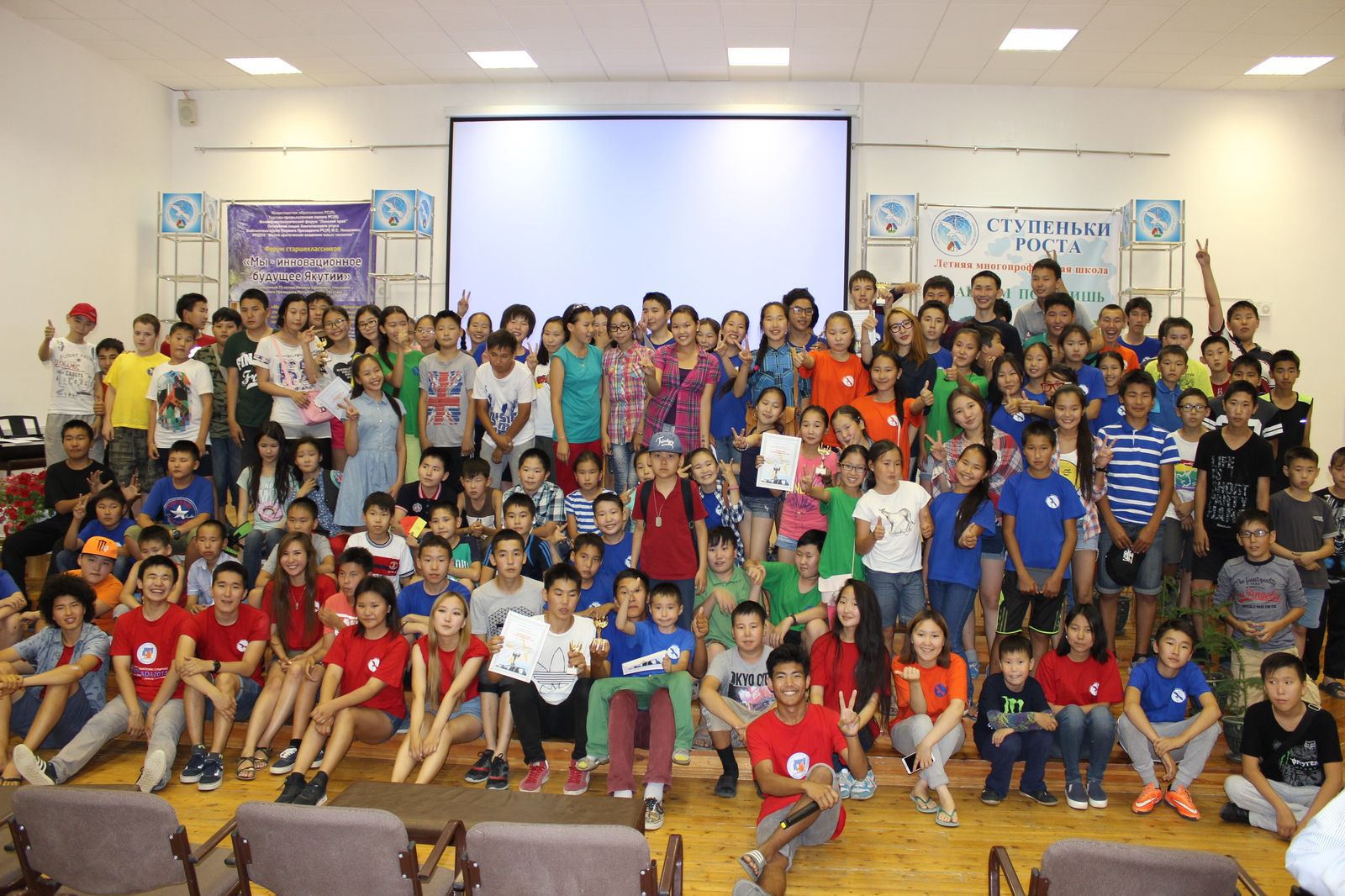
It so happened that the team of our company is not the first time taking part in conducting IT schools in various parts of our country. Our cooperation with the Yakutsk lyceums and technology parks in the form in which it is taking place today began last summer with classes in robotics at the Creation of the Future summer physics and mathematics school, which took place at the Lensky Krai forum in the village of Oktemtsi, Khangalassky ulus. I have already prepared a publication about it and I can get acquainted with it here: Summer PhMS of innovative projects “Creation of the Future”: how it was .
This year, we had the opportunity to participate in two robotics schools in 2 regions of Yakutia: in the Khangalassky Ulus and Amga. Next, I will tell you how they were organized, who “we” are, and what relation we have to these schools. Sit back - we begin.
This school is traditionally held every year in the small homeland of the First President of the Republic of Sakha (Yakutia) - in the village of Oktemtsy, Khangalassky ulus. However, until this year this school was held only on the basis of the Lensky Krai forum, which itself was fully responsible for the conduct and organization of this school. In the same year, by decree of Nikolaev Mikhail Efimovich, the school was organized right away on 3 sites located in Oktemtsi: at the Lensky Krai forum, on the basis of the Oktemsky Lyceum technopark and with the support of the library funds of the Republican Museum of the First President of the Republic M. Nikolaev Since this year we were invited not by the forum, but by the Oktemsky technopark, and worked mainly in it, then I will most fully talk about what happened in the technopark, but I will also try to cover the events,
A little about us and why we are so good :)
This year, 2 people went to host summer schools: RobotGeeks, Projects Project Manager, he is also an assistant professor of the Department of Robotic Systems and Mechatronics, MSTU named after N.E. Bauman - Sergey Anatolyevich Vorotnikov, and I, the author of this publication, is Alexey Olegovich Panfilov. We together, not for the first time working in tandem, achieved good results, primarily due to a real understanding of each other's capabilities and skills - S. Vorotnikov I was primarily engaged in methodological work, giving theoretical lectures and conducting the research part of the projects being carried out, and I was responsible for the entire technical part and the practical classes. Everything was as usual here. Our coordinator at the School was Marina Petrovna Alekseeva, the head of the Oktemsk technology park and just a wonderful person.
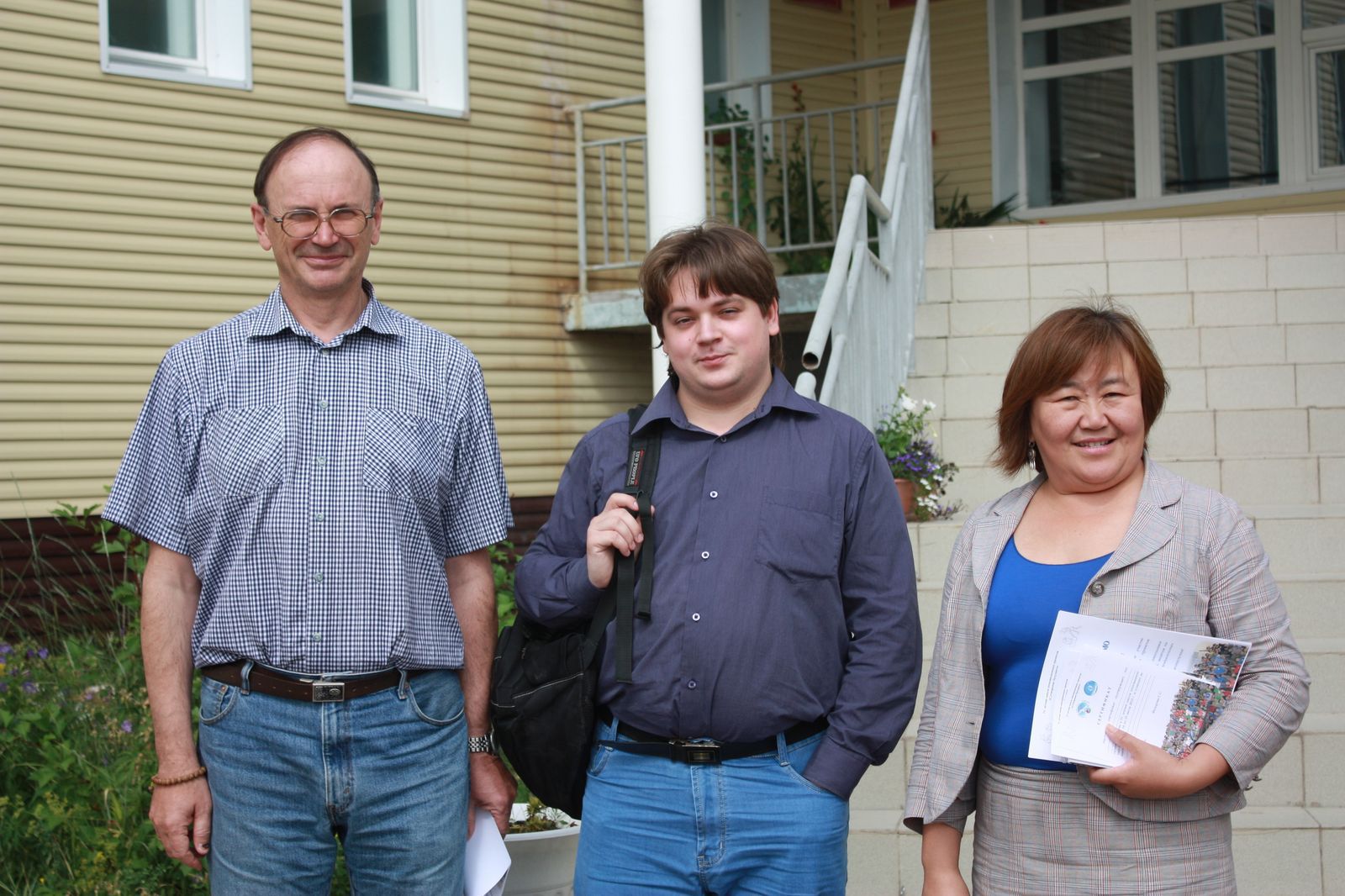
Our top-top team
How it all began and was arranged.
I described my feelings about the state of the central part of Yakutia and the roads along which we had to get to the venue of the School in the first article. This summer arrival, I have not seen anything new. But this is only for now. This year, unlike the previous year, we were accommodated in a lyceum hotel, which corresponds to about 3 stars in level, which for us, not very spoiled Muscovites, was pleasant, but not very necessary (in the past we lived in a general hostel for students, which, incidentally, is an order of magnitude better than typical student hostels in Moscow). Nutrition of us throughout the School was carried out on the basis of a lyceum boarding school, where pupils of the lyceum live throughout the year, but according to a strict schedule - 8.00 - breakfast, 13.00 - lunch, 18.00 - dinner, 21.30 - late dinner. The level of feeding was quite decent. We were pleased. I would like to separately note the fact that the entire contingent of participants was conditionally divided into 2 parts: “forum” and “lyceum”, which resulted in a kind of disunity in terms of organization, which in turn affected the separation in terms of accommodation of participants and organization of their food . "Lyceum" lived in a lyceum boarding school and ate there, "forum" lived in the hostel of the forum, and ate in the forum cafeteria. This division of participants, contributed to the division into specializations, primarily focusing on areas of interest to the lyceum, however, as practice has shown, the coordination of the organization of the educational and domestic process caused difficulties, but since Alekseeva M.P. dealt with these issues they didn’t really bother us, but exactly as long as this disunity did not begin to affect our educational process. This influence was primarily due to the lack of discipline at events common to all: the children were noisy, walked back and forth, in general, did everything, except what was needed. Expressing our dissatisfaction with the lack of organization in terms of discipline, we were surprised to find that the forum and lyceum organizers were divided into 2 sides: the forum believed that everything was fine, but the lyceum tried to fix something. In general, as usual, consensus could not be reached, well, okay. As I already said - we worked mainly in the technology park, where everything was in order with discipline, and one-time events for all we could endure. This influence was primarily due to the lack of discipline at events common to all: the children were noisy, walked back and forth, in general, did everything, except what was needed. Expressing our dissatisfaction with the lack of organization in terms of discipline, we were surprised to find that the forum and lyceum organizers were divided into 2 sides: the forum believed that everything was fine, but the lyceum tried to fix something. In general, as usual, consensus could not be reached, well, okay. As I already said - we worked mainly in the technology park, where everything was in order with discipline, and one-time events for all we could endure. This influence was primarily due to the lack of discipline at events common to all: the children were noisy, walked back and forth, in general, did everything, except what was needed. Expressing our dissatisfaction with the lack of organization in terms of discipline, we were surprised to find that the forum and lyceum organizers were divided into 2 sides: the forum believed that everything was fine, but the lyceum tried to fix something. In general, as usual, consensus could not be reached, well, okay. As I already said - we worked mainly in the technology park, where everything was in order with discipline, and one-time events for all we could endure. Expressing our dissatisfaction with the lack of organization in terms of discipline, we were surprised to find that the forum and lyceum organizers were divided into 2 sides: the forum believed that everything was fine, but the lyceum tried to fix something. In general, as usual, consensus could not be reached, well, okay. As I already said - we worked mainly in the technology park, where everything was in order with discipline, and one-time events for all we could endure. Expressing our dissatisfaction with the lack of organization in terms of discipline, we were surprised to find that the forum and lyceum organizers were divided into 2 sides: the forum believed that everything was fine, but the lyceum tried to fix something. In general, as usual, consensus could not be reached, well, okay. As I already said - we worked mainly in the technology park, where everything was in order with discipline, and one-time events for all we could endure.
What did the children do in the school?
First, a little about the children. Since LSHIP has the status of a republican school, children gathered for it from all over the republic, and even from Yakutsk itself. In total this year, more than 70 students from 4th to 11th grade took part in the School. So the contingent was very diverse. As I said earlier, this year 3 sites were immediately involved in which school events were held. Also, the combination of forum resources and technopark resources in terms of technical equipment and territory made it possible to organize as many as 7 areas in which children could engage. However, since the contingent was motley, in certain areas there was a conditional division into subgroups, allowing those guys with different levels of training to do what was interesting to them. As a result, 10 groups were organized, with each of which a separate teacher was engaged or 2 teachers at once, for example, as in our case. Heads of directions were invited mainly from leading schools and universities of Yakutia, so students were involved in some groups. Since the main condition for studying at the School was the protection of their own project (protection was allowed in small groups), within each group the guys were divided into subgroups to carry out their project. But, there were those who carried out their project alone. Now I will tell you more about each of the areas. Since the main condition for studying at the School was the protection of their own project (protection was allowed in small groups), within each group the guys were divided into subgroups to carry out their project. But, there were those who carried out their project alone. Now I will tell you more about each of the areas. Since the main condition for studying at the School was the protection of their own project (protection was allowed in small groups), within each group the guys were divided into subgroups to carry out their project. But, there were those who carried out their project alone. Now I will tell you more about each of the areas.
1. Designing Android applications.
As part of this area, participants were invited to get acquainted with the Android Studio environment, try to program on JS, and as a result, exit with their application for protection. Classes with schoolchildren were conducted by V.N. Pesterev, a student of IMI NEFU and Borisov V.S., a research associate of IMI NEFU. In the framework of this direction, 5 projects were completed - in fact, 5 unpretentious applications were written, the most interesting of which, in my opinion, were a GPS tracker, and the game is Right and Wrong.
2. 3D modeling
Students who chose this direction were trained to work in 3DMax, and again the direction was divided into 2 groups, with which A. Yakovlev, an IT teacher from the Yakutsk cadet school, and EA Petrova, a senior teacher, were engaged THEM NEFU.
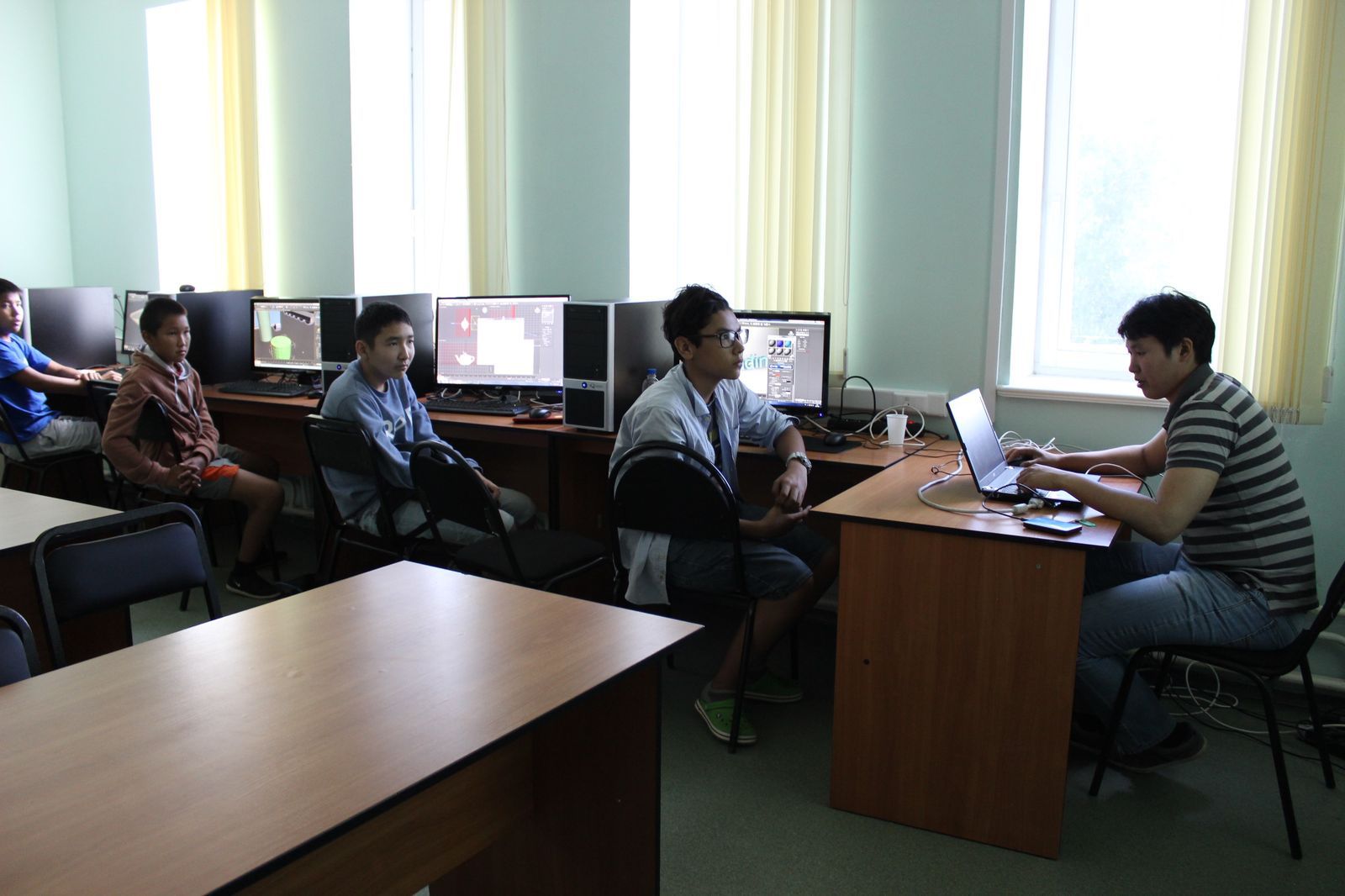
As part of this area, the guys realized a number of their ideas, which consisted in modeling various objects and structures. From my point of view, despite the fact that some models looked very cool (for example, a tank model with very cool detail), all projects clearly lacked an idea of why and why these models are being made. Therefore, it is difficult to call what students were engaged in as project activities in the classical sense of the word “project”. As a result, it turned out as a good master class on teaching work in 3D Mach, but not as the lead of your project.
3. Design is not based on unusual laws of physics.
Despite the not-so-clear name, the essence of the work in this direction came down to experimental physics / chemistry, in which the children conducted a series of experiments and offered creative ideas for using some interesting properties of unusual materials in our lives. The result of the work in this area were 4 projects:
- Visual evidence of the harm of Coca Cola
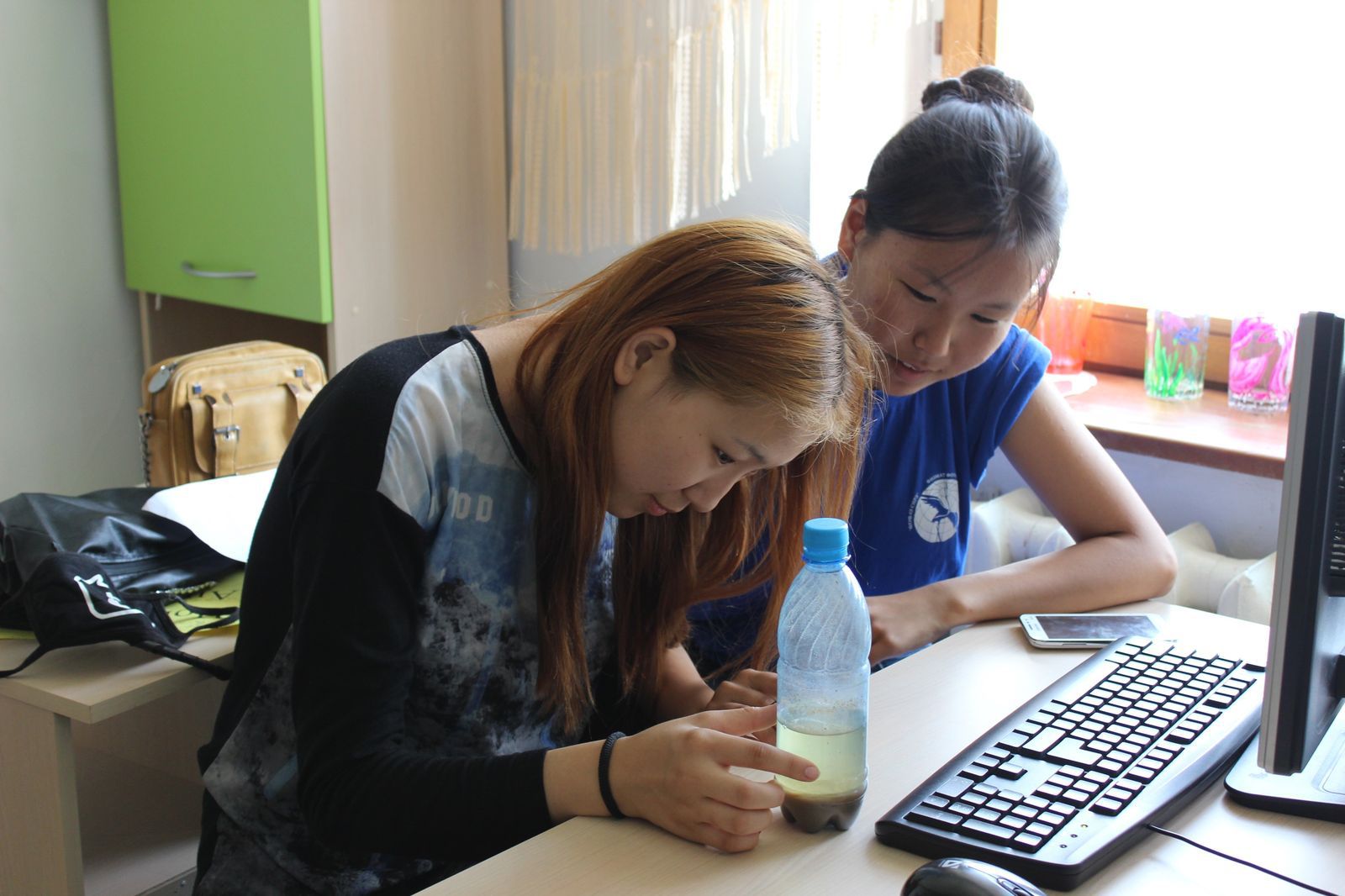
- Generation of electricity using the forces of the flow of water
- Architectural bionics
- Non-Newtonian fluid to cover road pits.
The leader of all these projects was Sharaborin E.L. from Moscow Physics and Technology.

4. Lego Mindstorms
Well, where in our time the development of educational robotics without Lego. The youngest participants of the School mainly rushed to this direction, but there were also enough elders there. All the projects implemented in this direction were fairly typical for Leg'ovskih sets - either something is going somewhere slowly, or something is standing still and moving.

This time, Sveshnikova L.M., a teacher of computer science from the YAGL and Prokopyev E.V., a teacher of computer science from the Ozhulunsky secondary school, supervised this area. From my point of view, the only non-trivial project that was presented in this direction was the project for smart housing lighting, primarily because an unconventional look at the designers of Lego was made within its framework. It is a pity that such a solution can only act as a model, when as an implementation of such a project on arduino it would bring a much greater profit.
5. Creative robotics + English
The most exotic destination of all. First of all, thanks to his leader, local African American Michael. The smallest participants of the School in this area studied English, made simple robots and made a film with their participation. It all looked very unusual, entertaining and very exotic.
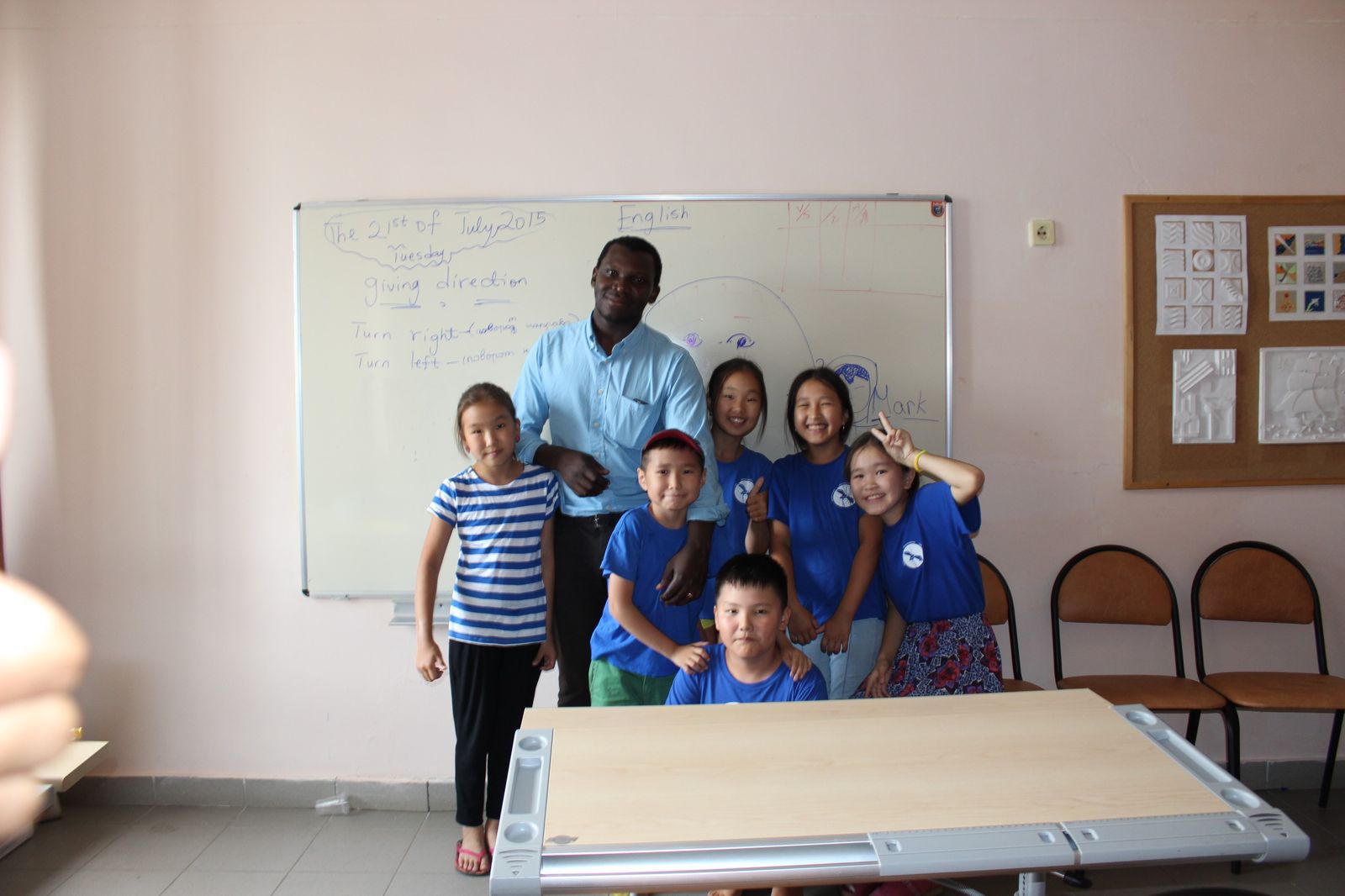
6. Innovation platform
The idea of an innovation platform was born in the spring, when the project of automatic irrigation system on the arduino hardware platform was implemented at the spring school of robotics. At this summer school, it was decided to try to implement this project in real life and use it for auto-watering flower beds, broken near the school technopark.
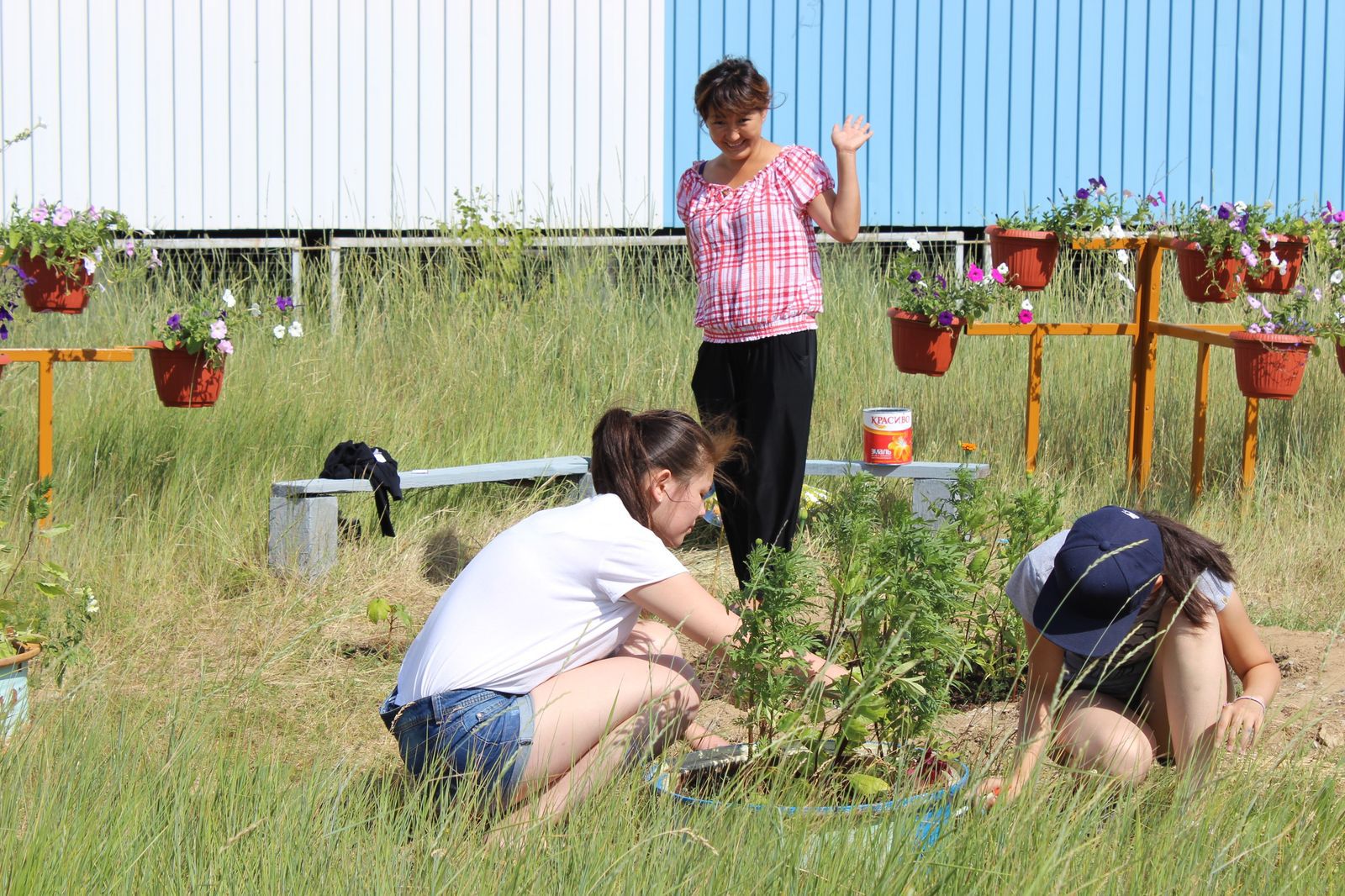
7. Design of autonomous robotic systems
The most “adult” and most serious direction in the framework of the School. Only iron, only hardcore. The smell of rosin and burnt components. Of the participants - only students in grades 10-11. From the equipment - everything that they could find. And we found a lot: 3 VEX constructors, 4 Bioloid Stem sets , 1 Bioloid Premium , a bunch of Arduino hardware platforms, countless different sensors and modules for arduino and, of course, electrical tape. Too bad it's not blue. And all this wealth for 5 people. Yes, in total we had 5 participants and each made his own individual project.

Since the 3rd participant is not the first time attending our robotics schools in Yakutia, I ventured to let everyone work separately from each other and with complete immersion. Complete immersion was expressed in the following:
- A separate, largest audience of the Oktemsky industrial park was allocated to us. We did not bother about the workspace - we used the places as much as we needed.
- Work began at 9.30 a.m. every day and ended at 6 p.m. Lunch break - 1.5 hours. Those who wish also came to work additionally after dinner - from 19.00 to 21-22 hours. And so 7 days in a row.
- Despite the fact that in Yakutia, in principle, there is trouble with the Internet, we have organized access to the Internet at a speed of up to 128 Kb / s.
In general, the working conditions were gorgeous. And all this resulted in 5 completed projects:
1. A multi-component mechatronic system with elements of technical vision. Completed by: Kapitonova Maria

In fact, this is a robotic arm assembled from Dynamixel servos from the designer of Bioloid Premium . The feature of the project is the presence of the HaViMo2.0 image recognition module, which is able to recognize the hand gestures that it sees. As an example, a game of stone-scissors-paper was demonstrated, in which the robot won with a probability of about 70-80%.
2. A two-component access control system in a secure room. Completed by: Kondratiev Leonid
Using an RFID reader, a laser module, a couple of servos and a handful of LEDs, Leonid using the Arduino hardware platform made a door model with a two-component access control system, and having painted a scenario according to which the object has / does not have the right to go through the door, he got a very effective protected door model “direct like in the movies". The door layout itself was assembled from VEX designer elements.

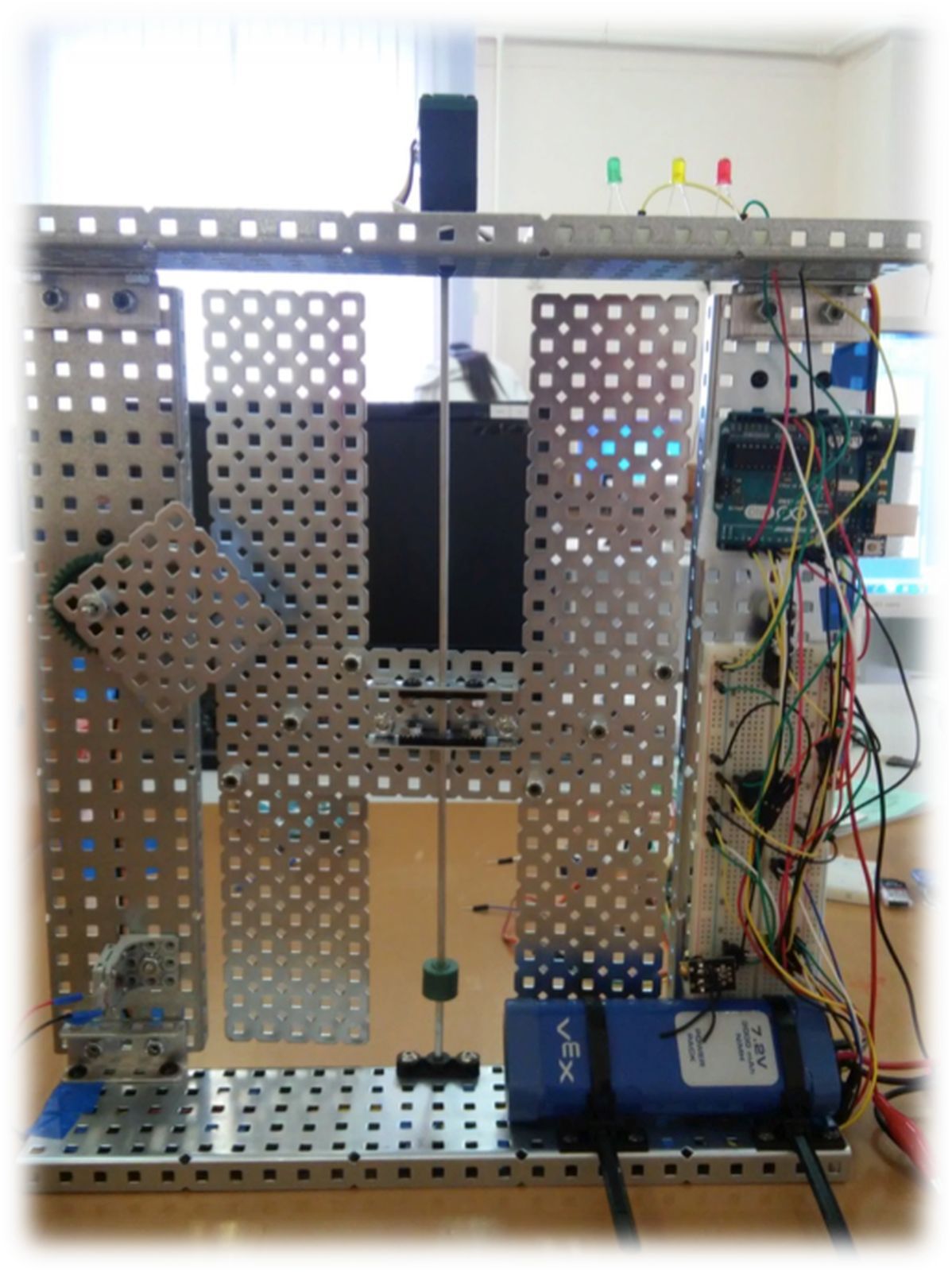
3. Robot fireman. Fulfilled: Ushnitsky Daniil
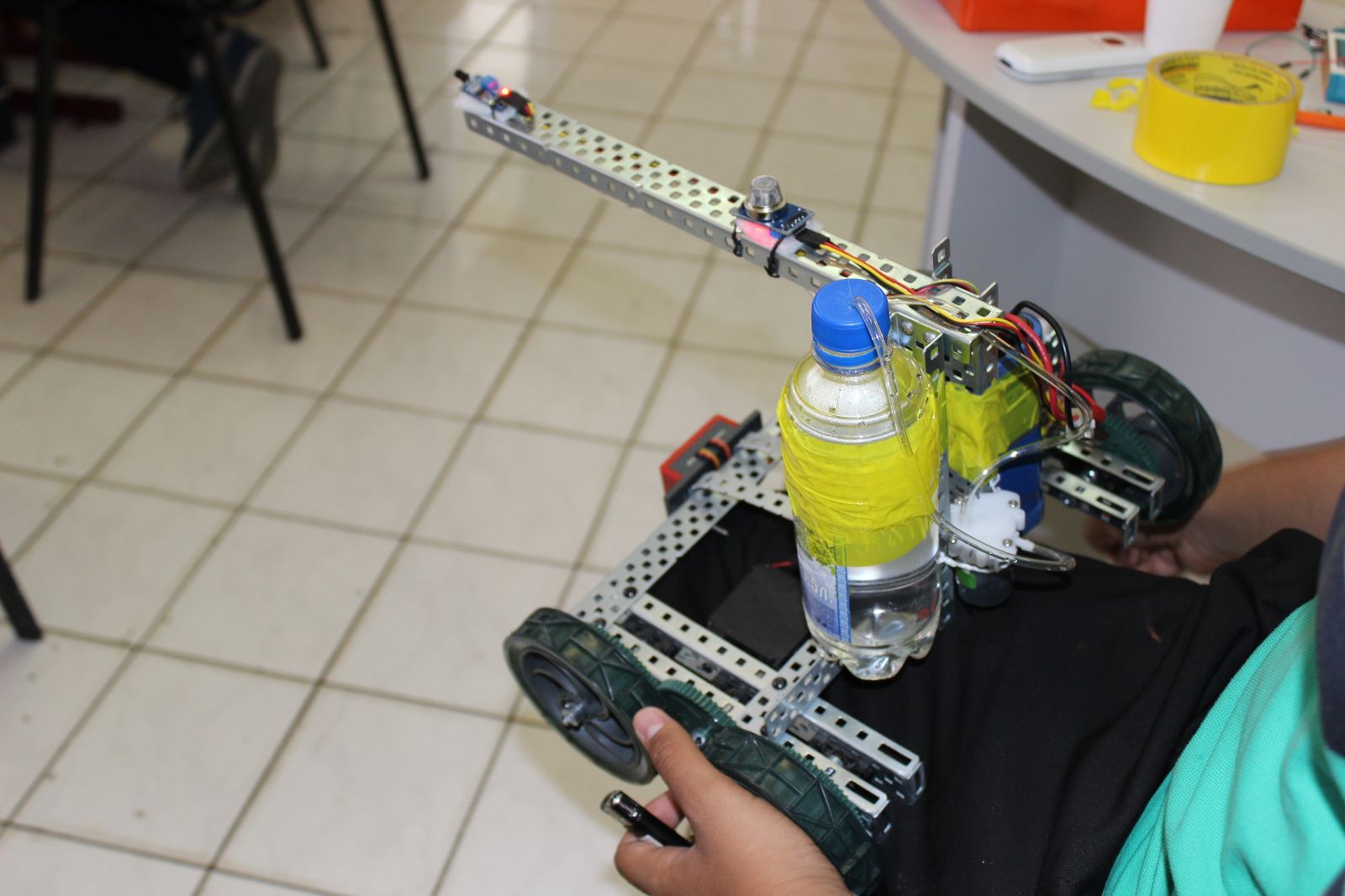
Using one of the simplest and most affordable VEX-CLAWBOT kits, Daniil made a fireman’s robot capable of analyzing the air for smoke in it, if it detects smoke, set off to search for fire, and extinguish it him using a micropump, using the available water supply.
4. Control the robot via Wi-Fi. Fulfilled: Kipriyanov Glory.
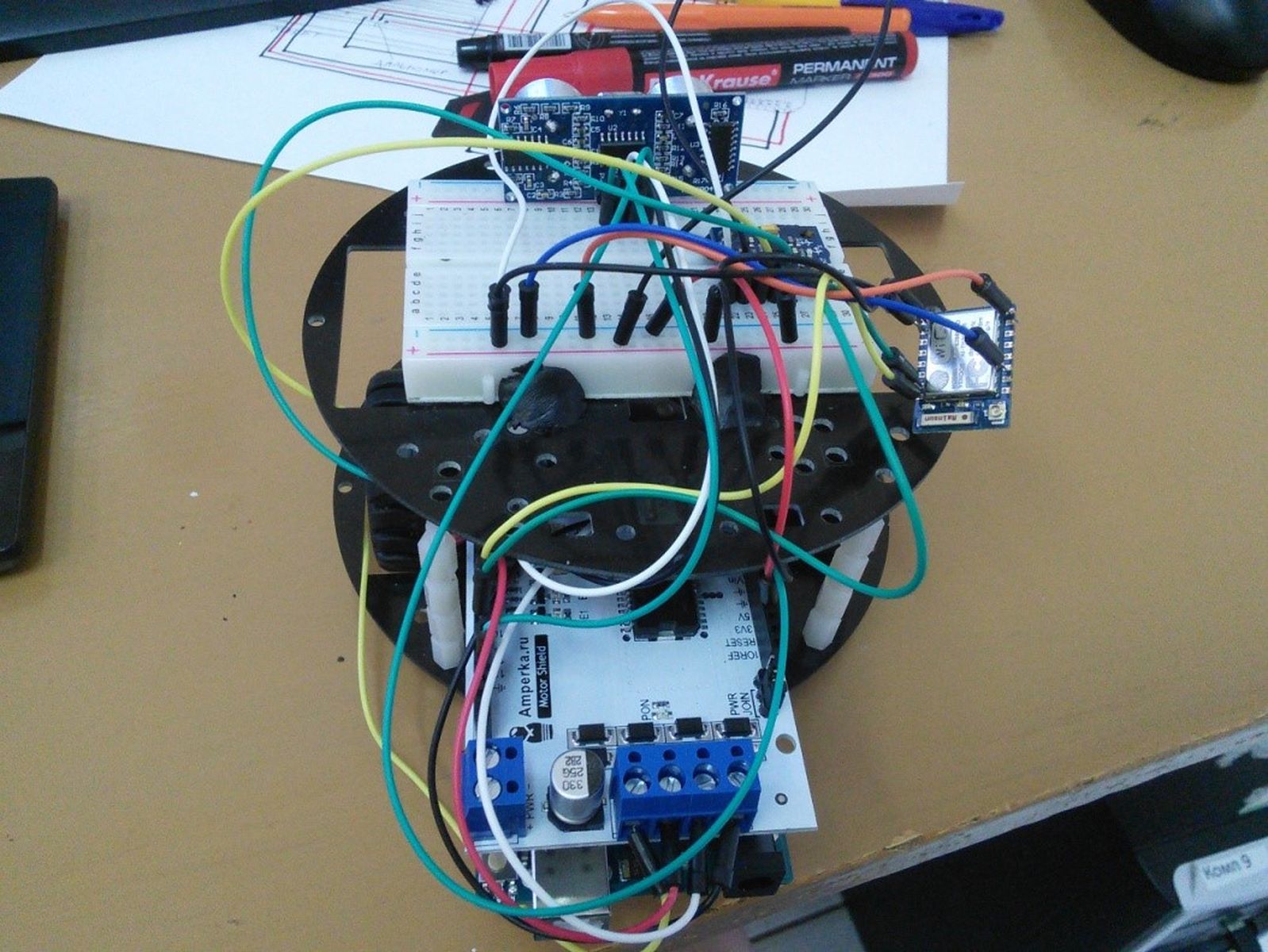
The objective of this project was, first of all, launching the esp8266 wi-fi module and mastering the process of working with it, and then linking it to a simple robot to demonstrate data exchange between the tablet and the robot. From the robot to the tablet, data came from the rangefinder and gyroscope installed on the robot chassis, and from the tablet, commands to move the robot.
5. Auto watering plants. Completed by: Popova Nurguyan.
This project carried out the applied part of the innovation platform. It was in the framework of work on this project that automation was born to control the automatic watering system. Hardcore hand-made as a result looked like this:
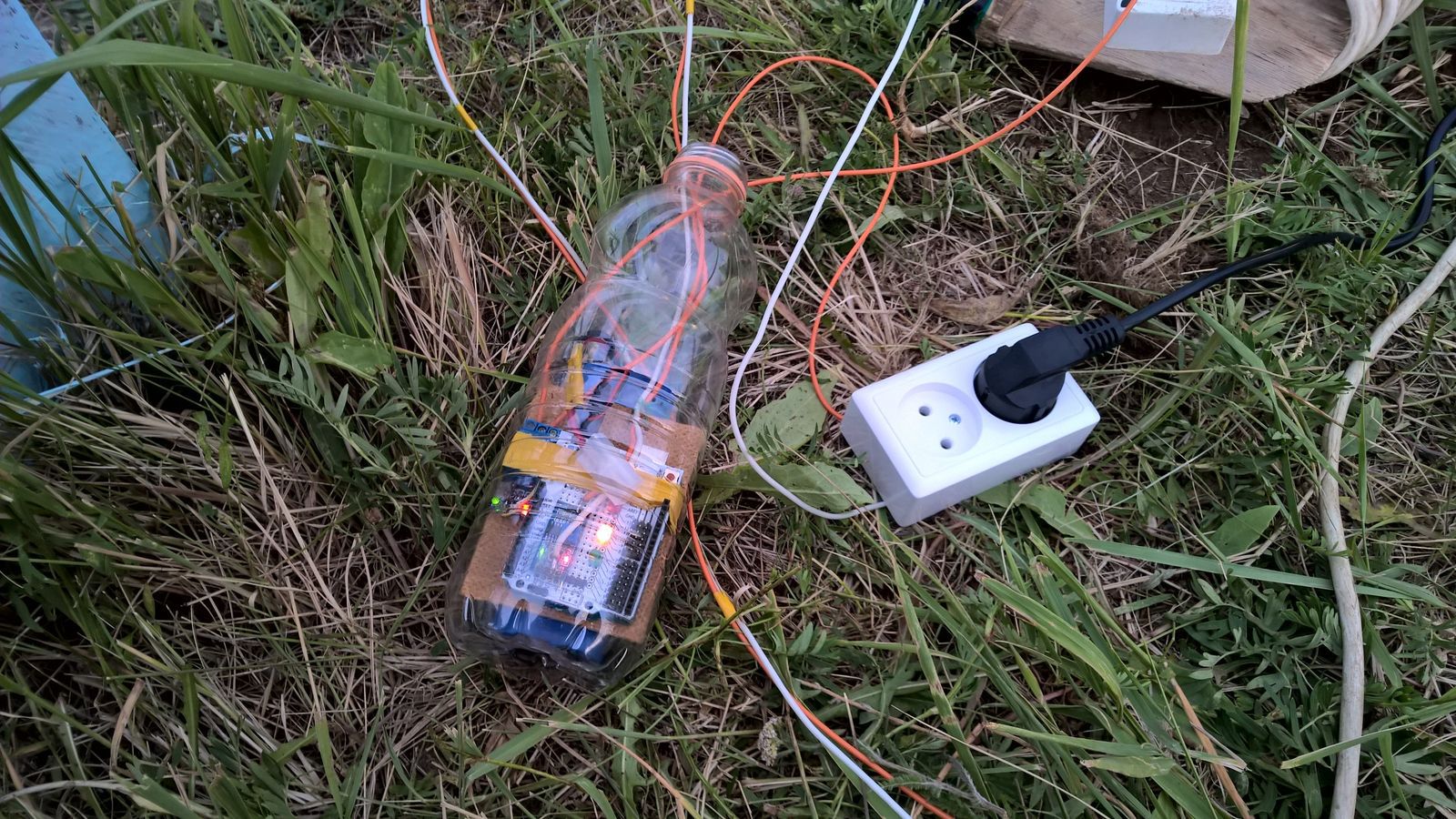
Despite the extended 220V line, the arduino board itself and the shields for it were powered by a VEX accumulator. This was done primarily in order to minimize the chance of short circuit in the 220V line.
These are the projects involved in the LSHIP participants. But do not think that everyone just did what they sat in the classroom from morning to night and pored over their iron. Of course, there was an entertainment program. I won’t be able to tell you about all the undertakings, as counselors were involved in the organization of mass events. From what I know were the following leisure activities:
1. One day, a trip was organized for children to the Orto Doydu Zoo, followed by barbecue in nature. Separately, I want to note the fact that despite the remote location of the zoo from large cities in terms of animal welfare, and in terms of their number, the zoo looks very cool. Camels are especially amazing. Especially in winter. Especially in the cold. Yakutia after all.
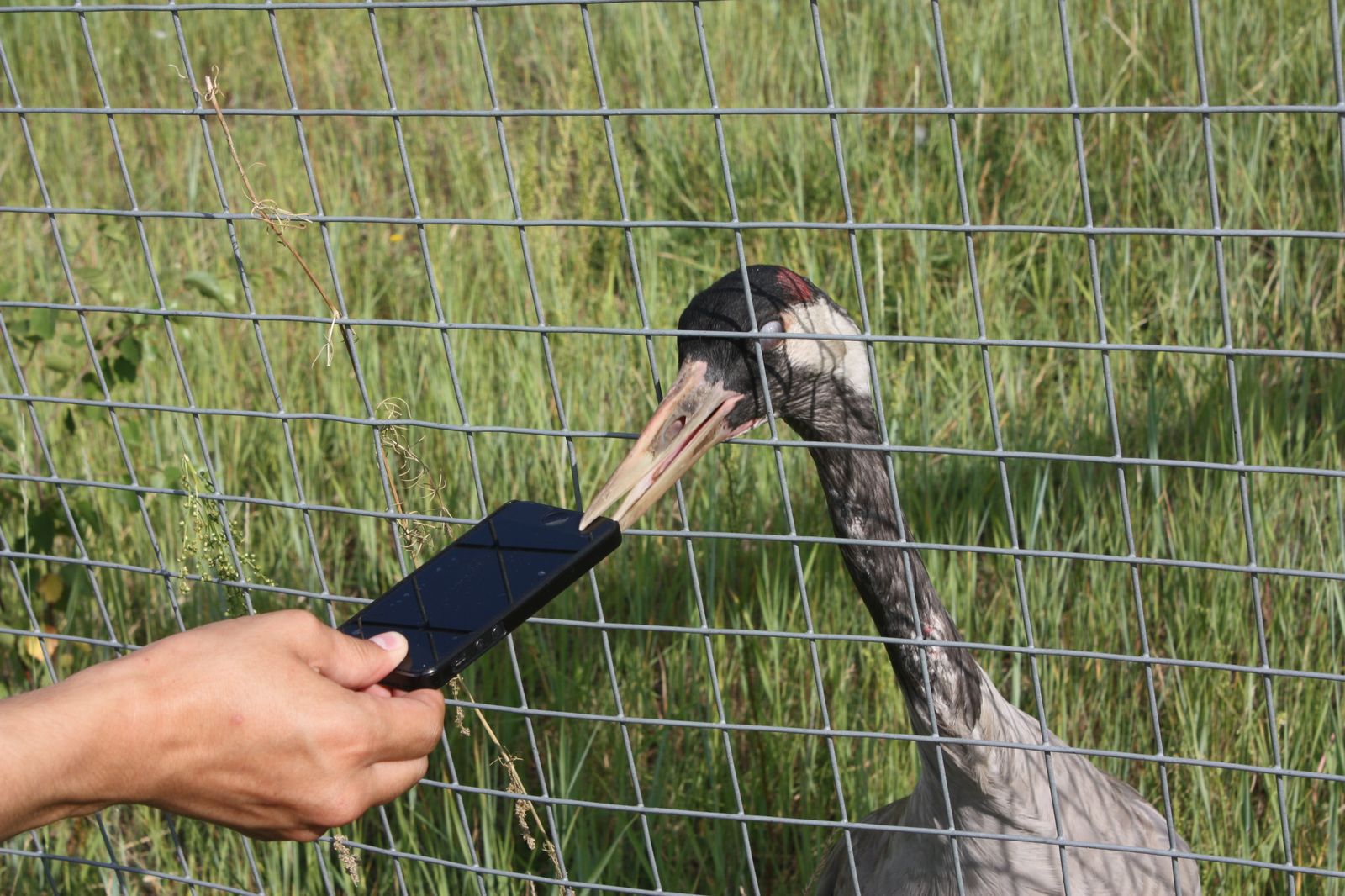
2. Several evenings were devoted to the acquaintance of students with modern literature. Such events were organized as part of a common idea - 2015 - Year of literature. Such evenings were held in the library on the basis of the 3rd site of the School - the museum. The director of the library, Kapitonova N.A., led these evenings. At these evenings, schoolchildren got acquainted with the current state of literature, works of great importance in art, and also performed poetry reading.
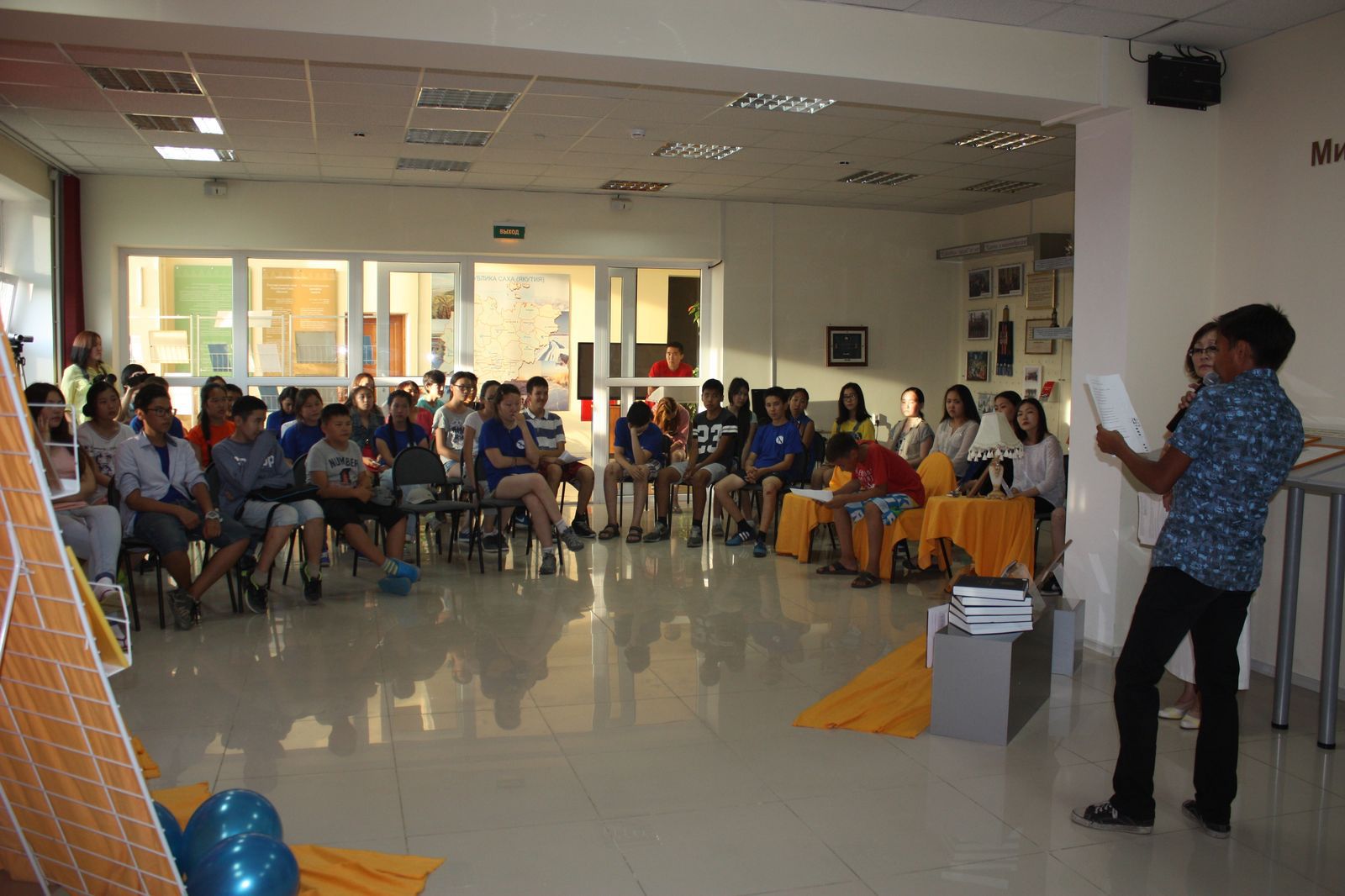
3. One evening, large-scale drawing on paper was organized, which then, of course, was transferred to all the painters. I did not understand what it was, but it looked funny from the side. And given that the children took part in this undertaking with great pleasure, they probably liked it very much.
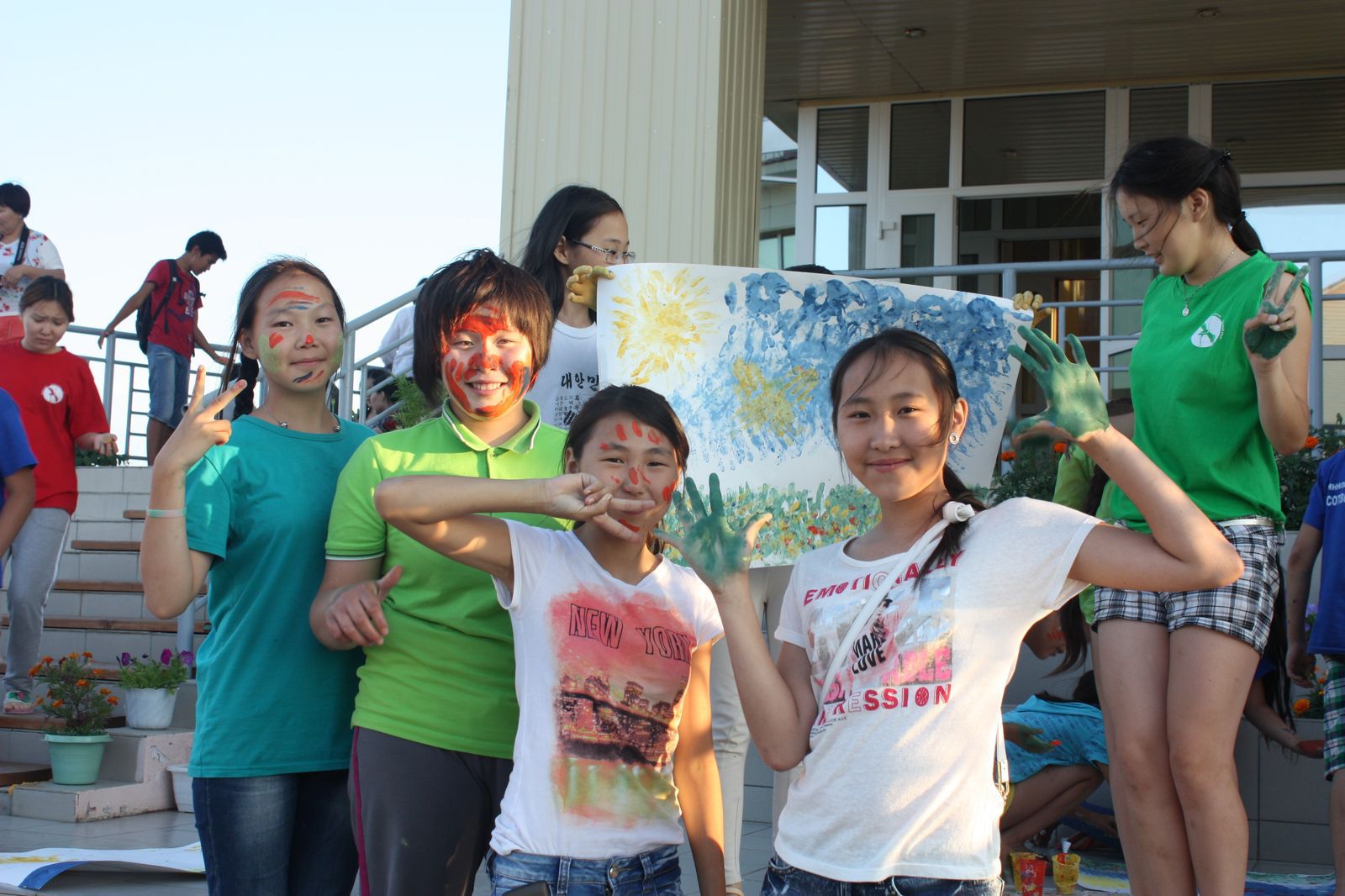
4. One of the most ambitious undertakings, in my opinion, was an undertaking with the filming of his film. All the guys at the beginning of the work of the School were divided into several teams and made films throughout the school. After which, of course, a film festival was organized with a red ribbon, the first show of his creations, and of course, Oscar-style awards. Everything looked very cool, but the films were in the Yakut language and we understood very little ... It's a shame.
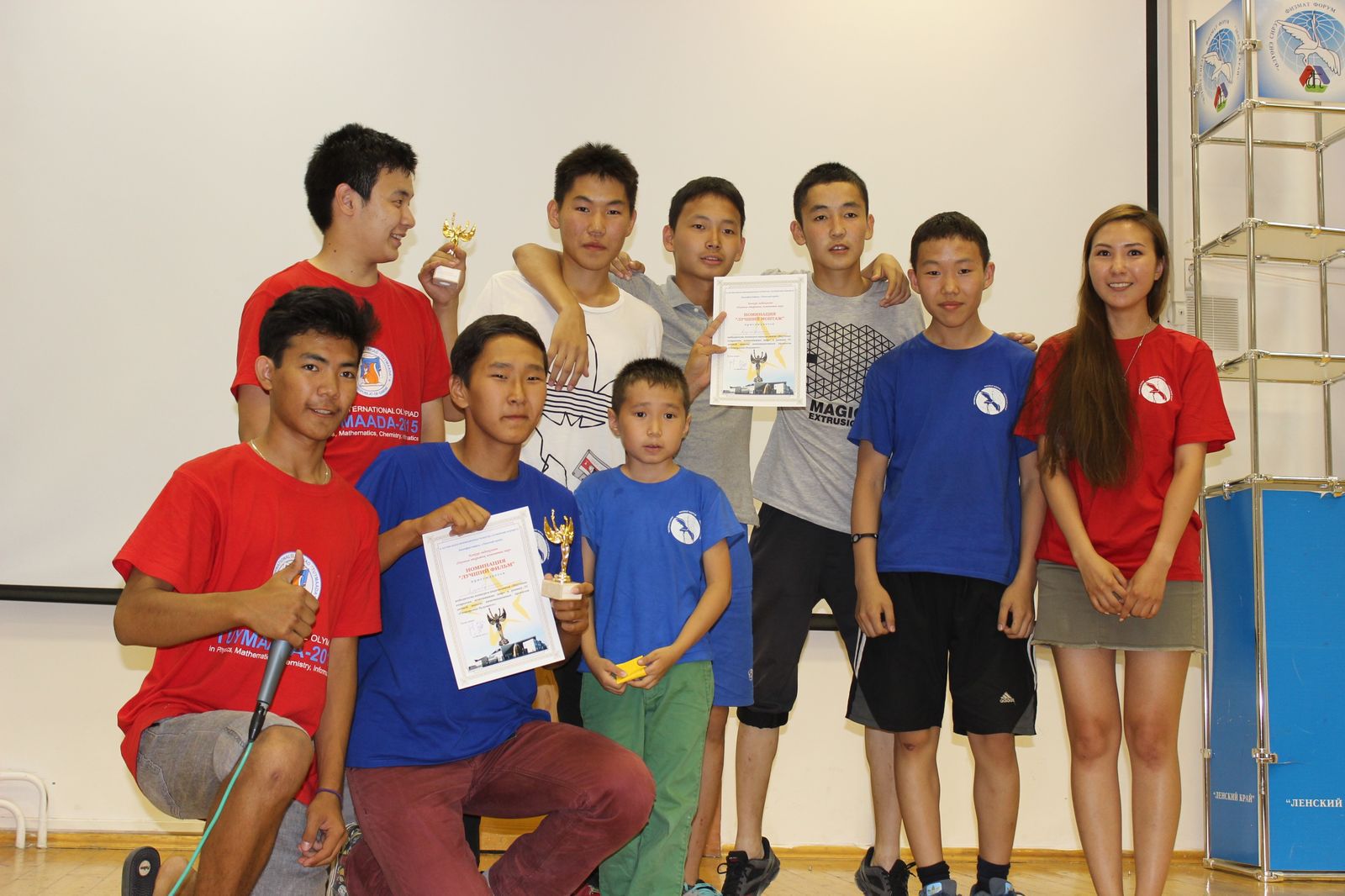
Well, the most ambitious undertaking was protecting projects and rewarding the winners. Project protection consisted of two parts - from the exhibition at which the guys presented their working samples and the defense itself, where the presentations of their projects were presented. At the stage of the exhibition, the jury evaluated the degree of complexity of the presented model, its performance and originality. At the defense stage, the relevance of the project, the formulation of goals and objectives, as well as an adequate presentation of the progress were already evaluated. Among other things, the presentation process itself was evaluated - how clear, beautiful and logical the presentation was. Since there were many projects, it was decided to separately evaluate the junior and senior participants of the School. For each group of assessed, the distribution of places was as follows: one first place, two second places and three third. Moreover,
Our youngest winners:

and the oldest with their leaders:

In addition to the main places, there was also a nomination for the most creative project, which the guys from the “physicists” took. It’s nice to boast that our guys from 5 projects took 4 prizes, and from the beginning. Well done!
In addition to working with children, we also held master classes with teachers, as well as two video conferences: one for teachers and school organizers - with representatives of CROC, and the other on experience exchange with the school of robotics at the Academy of Innovative Processes of Belarus . In the framework of the latter, the guys exchanged experiences and ideas with their comrades and, most importantly, agreed to hold online robotics competitions. The school completed its work on July 23, 2015, after which we stayed at Oktemsky Lyceum for 1 day, during which we met with the First President of the Republic of Sakha, Nikolayev M.E., and discussed the prospects for our cooperation in educational and industrial robotics, and then we went to another School - to the Uuneyis school camp (translated from Yakut - Rodnik) in Amga.
In one of the most famous regions of Yakutia - Amga, famous for its clean river - Amga and delicious strawberries, every year a camp for schoolchildren is traditionally organized, in which the guys not only relax and have fun, but also do various sciences. As a rule, the direction of the camp is different from the race - the first race this year was humanitarian - participants studied English, art, culture of Yakutia and Russia, etc., and the second race was devoted to technical disciplines: physics, robotics and 3D modeling.
Getting to this camp was not as easy as we would like ... The lack of a bridge across the Lena River makes it necessary to use ferry crossings, which are quite enough from Yakutsk, but nonetheless, it does not take much time. Having crossed the river we found ourselves in the kingdom of nature - the forest, the lack of roads in our usual sense, and wild animals running in front of the car ... Generally exotic. Speaking of the car - few cars are able to withstand the trip on what was called the road - and oddly enough, the most hardy and tenacious machine there is our, still Soviet, “loaf”, and the rest of the park is Japanese right-handed cars. Nothing else survives there. We had to drive 200 km to the camp, which we covered in 3 hours. But how extreme it was! Personally, I have long had a strong belief, that Yakut drivers drive at a speed of at least 100 km \ hour, regardless of whether there is a road under their wheels or not. For the sake of completeness, I was riding in the back seat of the “loaf” and felt the beauty of such a ride: take-offs on bumps, falls in pits, sharp turns left and right - in general I can say one thing - after such a ride, the roller coaster is nothing. Yes, as well as other rides with ups and downs. The first hour - one and a half, I was seriously afraid for my life, but then I realized that nothing personally depended on me already and relaxed. Now I understand why such philosophers are Yakuts ... Well, pretty lyrics. sharp turns left and right - in general I can say one thing - after such a ride the roller coaster is nothing. Yes, as well as other rides with ups and downs. The first hour - one and a half, I was seriously afraid for my life, but then I realized that nothing personally depended on me already and relaxed. Now I understand why such philosophers are Yakuts ... Well, pretty lyrics. sharp turns left and right - in general I can say one thing - after such a ride the roller coaster is nothing. Yes, as well as other rides with ups and downs. The first hour - one and a half, I was seriously afraid for my life, but then I realized that nothing personally depended on me already and relaxed. Now I understand why such philosophers are Yakuts ... Well, pretty lyrics.
The Uuneiis camp itself is located 3 km from the village of Amga and looks like a typical pioneer camp, namely, several hut houses for participants, a dining room, a shower - a typical booth with a water tank on the roof and a toilet of the “fun painted wooden house” type. I especially want to note that in this camp they really use devices for generating electricity and heating, the principle of which is based on an alternative energy source - the sun. To obtain electricity, solar panels are used as much as possible, solar panels are also used to heat water in the shower, and infrared heaters are used to heat rooms. And it really works - in the shower, the water heats up to 90 degrees Celsius, and a small solar battery is enough to illuminate several rooms, and also charge laptops and phones. Besides, the camp has sound equipment for disco and various events, projectors with screens, printers \ scanners and a large fleet of laptops for students. And this is not counting the equipment that, if necessary, is brought from the Amgin Lyceum - robotic kits and even 3D printers. So in spite of the seeming simplicity of arranging the camp - in fact, everything is very good.
Here is the dining room in the camp:
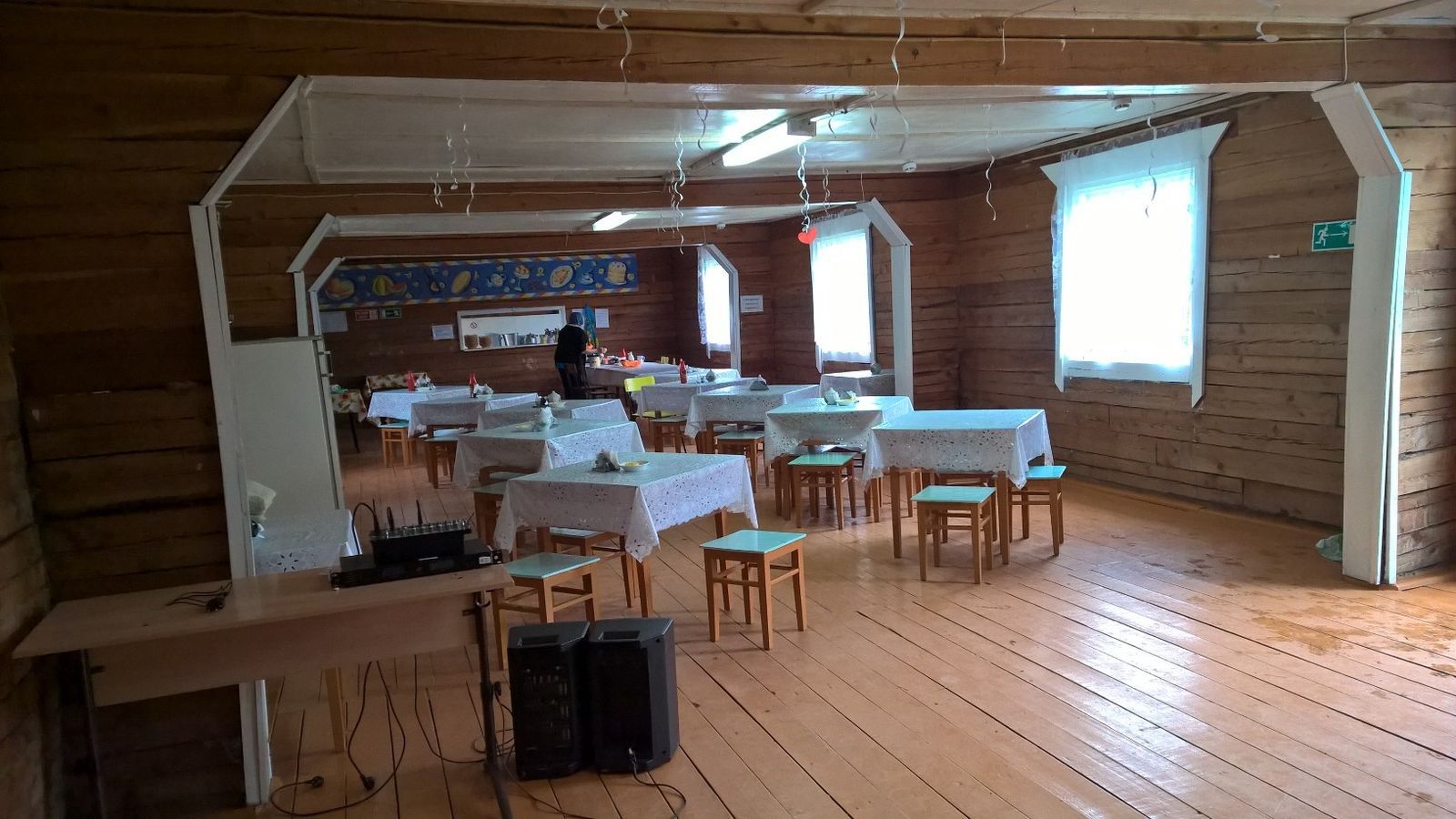
The guys live in the camp for 21 days, i.e. 3 weeks - each of which is allocated for a separate training course. But in our case, there was an overlay and with us in the camp there was a teacher from Krasnoyarsk, who was supposed to come after us and engage in physics with schoolchildren. However, we were not upset and consolidated our courses - Viktor Mikhailovich gave part of the lectures on physics in relation to robotics, Sergey Anatolyevich told about the history of robotics and sensors, and I was responsible for practical exercises. So, from some point of view, such a combination of courses looked even better, since questions were considered from all points of view: in physics, the guys got the base and the conceptual apparatus, in lectures they learned how it applies to iron, and in practice they really “felt” what was explained to them on the fingers.
Classes were held in small classrooms that could hardly accommodate everyone, so as for the learning space, it would be necessary to increase it. As you can see in the photographs below, these are quite simple classrooms, so the atmosphere of the classes was very colorful.
Classes in physics:

and practice in robotics:
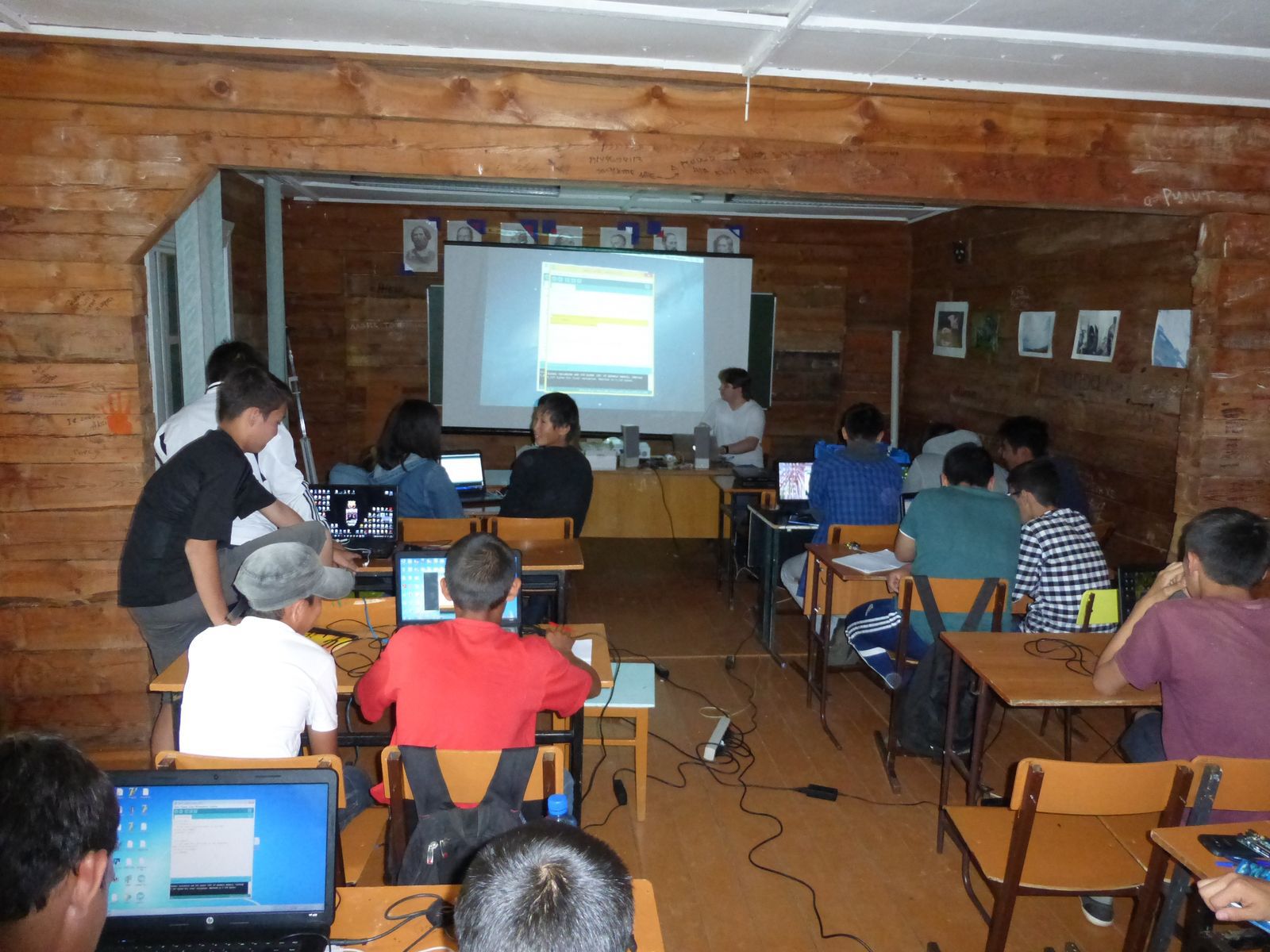
Since we saw these children for the first time, we did not take risks and engaged in simple projects with them using the arduino hardware platforms and the Vex constructor. Compared to LSHIP, more attention was paid to rest and less training in this camp, so some creative activities were constantly held in the camp. Since we were not in the camp for the whole shift, I don’t know the entire recreation program, however, the most memorable during our stay were a walk on Mount Korolenko and, in fact, the traditional defense of the projects. As for Mount Korolenko, this is the same Korolenko who wrote "Prisoners of the Underground", "Blind Musician", etc. Not far from the camp is a place - a gazebo, where he loved to relax and where he wrote his works.
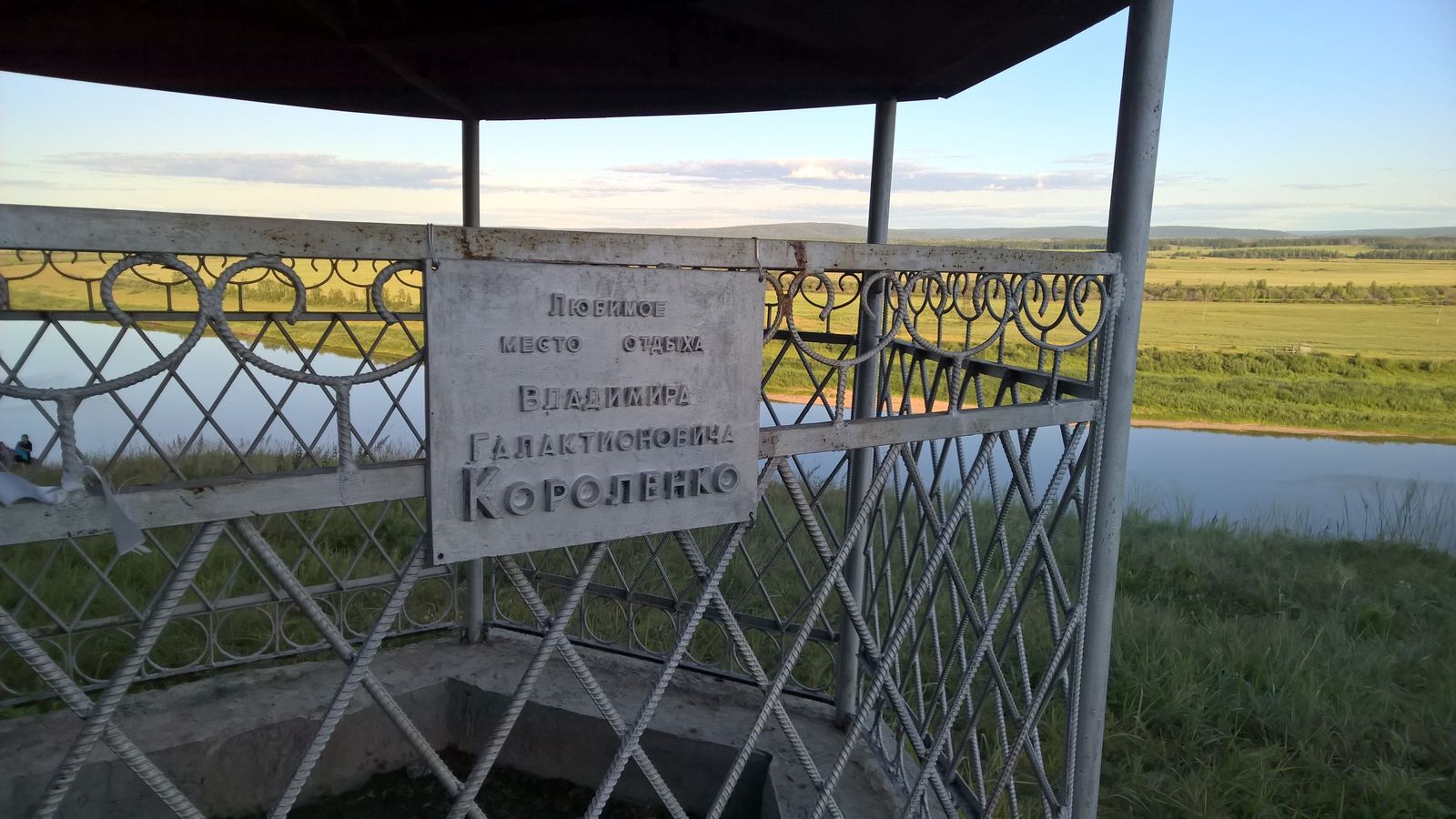
From this place, an amazing view of the valley and the river Amga itself opens. However, to go up there is a separate pleasure.
At the conclusion of our stay in the camp, projects were protected. 20 guys divided into 6 teams and presented their projects.
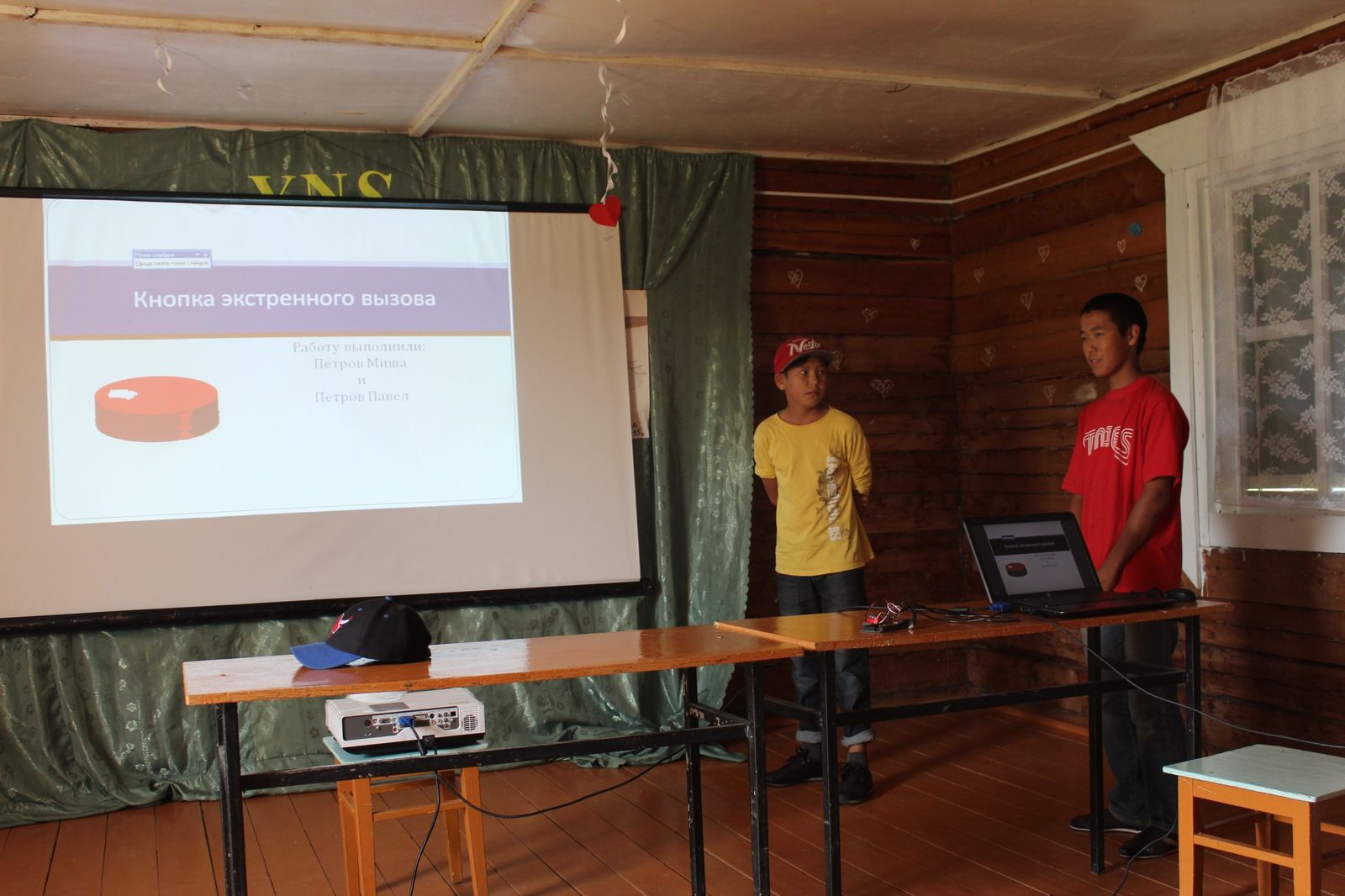
Well, in comparison with LSHIP at the Oktemtsi school in Hunaeis, in my opinion, one still needs to gain scope and power, but the atmosphere in the camp was very cool, and we were very pleased and did not regret that we arrived there. I hope this was not the last visit, and we will meet with the local students more than once and do not a single school. So see you soon!

It so happened that the team of our company is not the first time taking part in conducting IT schools in various parts of our country. Our cooperation with the Yakutsk lyceums and technology parks in the form in which it is taking place today began last summer with classes in robotics at the Creation of the Future summer physics and mathematics school, which took place at the Lensky Krai forum in the village of Oktemtsi, Khangalassky ulus. I have already prepared a publication about it and I can get acquainted with it here: Summer PhMS of innovative projects “Creation of the Future”: how it was .
This year, we had the opportunity to participate in two robotics schools in 2 regions of Yakutia: in the Khangalassky Ulus and Amga. Next, I will tell you how they were organized, who “we” are, and what relation we have to these schools. Sit back - we begin.
Creation of the Future Summer School of Innovation Projects
This school is traditionally held every year in the small homeland of the First President of the Republic of Sakha (Yakutia) - in the village of Oktemtsy, Khangalassky ulus. However, until this year this school was held only on the basis of the Lensky Krai forum, which itself was fully responsible for the conduct and organization of this school. In the same year, by decree of Nikolaev Mikhail Efimovich, the school was organized right away on 3 sites located in Oktemtsi: at the Lensky Krai forum, on the basis of the Oktemsky Lyceum technopark and with the support of the library funds of the Republican Museum of the First President of the Republic M. Nikolaev Since this year we were invited not by the forum, but by the Oktemsky technopark, and worked mainly in it, then I will most fully talk about what happened in the technopark, but I will also try to cover the events,
A little about us and why we are so good :)
This year, 2 people went to host summer schools: RobotGeeks, Projects Project Manager, he is also an assistant professor of the Department of Robotic Systems and Mechatronics, MSTU named after N.E. Bauman - Sergey Anatolyevich Vorotnikov, and I, the author of this publication, is Alexey Olegovich Panfilov. We together, not for the first time working in tandem, achieved good results, primarily due to a real understanding of each other's capabilities and skills - S. Vorotnikov I was primarily engaged in methodological work, giving theoretical lectures and conducting the research part of the projects being carried out, and I was responsible for the entire technical part and the practical classes. Everything was as usual here. Our coordinator at the School was Marina Petrovna Alekseeva, the head of the Oktemsk technology park and just a wonderful person.

Our top-top team
How it all began and was arranged.
I described my feelings about the state of the central part of Yakutia and the roads along which we had to get to the venue of the School in the first article. This summer arrival, I have not seen anything new. But this is only for now. This year, unlike the previous year, we were accommodated in a lyceum hotel, which corresponds to about 3 stars in level, which for us, not very spoiled Muscovites, was pleasant, but not very necessary (in the past we lived in a general hostel for students, which, incidentally, is an order of magnitude better than typical student hostels in Moscow). Nutrition of us throughout the School was carried out on the basis of a lyceum boarding school, where pupils of the lyceum live throughout the year, but according to a strict schedule - 8.00 - breakfast, 13.00 - lunch, 18.00 - dinner, 21.30 - late dinner. The level of feeding was quite decent. We were pleased. I would like to separately note the fact that the entire contingent of participants was conditionally divided into 2 parts: “forum” and “lyceum”, which resulted in a kind of disunity in terms of organization, which in turn affected the separation in terms of accommodation of participants and organization of their food . "Lyceum" lived in a lyceum boarding school and ate there, "forum" lived in the hostel of the forum, and ate in the forum cafeteria. This division of participants, contributed to the division into specializations, primarily focusing on areas of interest to the lyceum, however, as practice has shown, the coordination of the organization of the educational and domestic process caused difficulties, but since Alekseeva M.P. dealt with these issues they didn’t really bother us, but exactly as long as this disunity did not begin to affect our educational process. This influence was primarily due to the lack of discipline at events common to all: the children were noisy, walked back and forth, in general, did everything, except what was needed. Expressing our dissatisfaction with the lack of organization in terms of discipline, we were surprised to find that the forum and lyceum organizers were divided into 2 sides: the forum believed that everything was fine, but the lyceum tried to fix something. In general, as usual, consensus could not be reached, well, okay. As I already said - we worked mainly in the technology park, where everything was in order with discipline, and one-time events for all we could endure. This influence was primarily due to the lack of discipline at events common to all: the children were noisy, walked back and forth, in general, did everything, except what was needed. Expressing our dissatisfaction with the lack of organization in terms of discipline, we were surprised to find that the forum and lyceum organizers were divided into 2 sides: the forum believed that everything was fine, but the lyceum tried to fix something. In general, as usual, consensus could not be reached, well, okay. As I already said - we worked mainly in the technology park, where everything was in order with discipline, and one-time events for all we could endure. This influence was primarily due to the lack of discipline at events common to all: the children were noisy, walked back and forth, in general, did everything, except what was needed. Expressing our dissatisfaction with the lack of organization in terms of discipline, we were surprised to find that the forum and lyceum organizers were divided into 2 sides: the forum believed that everything was fine, but the lyceum tried to fix something. In general, as usual, consensus could not be reached, well, okay. As I already said - we worked mainly in the technology park, where everything was in order with discipline, and one-time events for all we could endure. Expressing our dissatisfaction with the lack of organization in terms of discipline, we were surprised to find that the forum and lyceum organizers were divided into 2 sides: the forum believed that everything was fine, but the lyceum tried to fix something. In general, as usual, consensus could not be reached, well, okay. As I already said - we worked mainly in the technology park, where everything was in order with discipline, and one-time events for all we could endure. Expressing our dissatisfaction with the lack of organization in terms of discipline, we were surprised to find that the forum and lyceum organizers were divided into 2 sides: the forum believed that everything was fine, but the lyceum tried to fix something. In general, as usual, consensus could not be reached, well, okay. As I already said - we worked mainly in the technology park, where everything was in order with discipline, and one-time events for all we could endure.
What did the children do in the school?
First, a little about the children. Since LSHIP has the status of a republican school, children gathered for it from all over the republic, and even from Yakutsk itself. In total this year, more than 70 students from 4th to 11th grade took part in the School. So the contingent was very diverse. As I said earlier, this year 3 sites were immediately involved in which school events were held. Also, the combination of forum resources and technopark resources in terms of technical equipment and territory made it possible to organize as many as 7 areas in which children could engage. However, since the contingent was motley, in certain areas there was a conditional division into subgroups, allowing those guys with different levels of training to do what was interesting to them. As a result, 10 groups were organized, with each of which a separate teacher was engaged or 2 teachers at once, for example, as in our case. Heads of directions were invited mainly from leading schools and universities of Yakutia, so students were involved in some groups. Since the main condition for studying at the School was the protection of their own project (protection was allowed in small groups), within each group the guys were divided into subgroups to carry out their project. But, there were those who carried out their project alone. Now I will tell you more about each of the areas. Since the main condition for studying at the School was the protection of their own project (protection was allowed in small groups), within each group the guys were divided into subgroups to carry out their project. But, there were those who carried out their project alone. Now I will tell you more about each of the areas. Since the main condition for studying at the School was the protection of their own project (protection was allowed in small groups), within each group the guys were divided into subgroups to carry out their project. But, there were those who carried out their project alone. Now I will tell you more about each of the areas.
1. Designing Android applications.
As part of this area, participants were invited to get acquainted with the Android Studio environment, try to program on JS, and as a result, exit with their application for protection. Classes with schoolchildren were conducted by V.N. Pesterev, a student of IMI NEFU and Borisov V.S., a research associate of IMI NEFU. In the framework of this direction, 5 projects were completed - in fact, 5 unpretentious applications were written, the most interesting of which, in my opinion, were a GPS tracker, and the game is Right and Wrong.
2. 3D modeling
Students who chose this direction were trained to work in 3DMax, and again the direction was divided into 2 groups, with which A. Yakovlev, an IT teacher from the Yakutsk cadet school, and EA Petrova, a senior teacher, were engaged THEM NEFU.

As part of this area, the guys realized a number of their ideas, which consisted in modeling various objects and structures. From my point of view, despite the fact that some models looked very cool (for example, a tank model with very cool detail), all projects clearly lacked an idea of why and why these models are being made. Therefore, it is difficult to call what students were engaged in as project activities in the classical sense of the word “project”. As a result, it turned out as a good master class on teaching work in 3D Mach, but not as the lead of your project.
3. Design is not based on unusual laws of physics.
Despite the not-so-clear name, the essence of the work in this direction came down to experimental physics / chemistry, in which the children conducted a series of experiments and offered creative ideas for using some interesting properties of unusual materials in our lives. The result of the work in this area were 4 projects:
- Visual evidence of the harm of Coca Cola

- Generation of electricity using the forces of the flow of water
- Architectural bionics
- Non-Newtonian fluid to cover road pits.
The leader of all these projects was Sharaborin E.L. from Moscow Physics and Technology.

4. Lego Mindstorms
Well, where in our time the development of educational robotics without Lego. The youngest participants of the School mainly rushed to this direction, but there were also enough elders there. All the projects implemented in this direction were fairly typical for Leg'ovskih sets - either something is going somewhere slowly, or something is standing still and moving.

This time, Sveshnikova L.M., a teacher of computer science from the YAGL and Prokopyev E.V., a teacher of computer science from the Ozhulunsky secondary school, supervised this area. From my point of view, the only non-trivial project that was presented in this direction was the project for smart housing lighting, primarily because an unconventional look at the designers of Lego was made within its framework. It is a pity that such a solution can only act as a model, when as an implementation of such a project on arduino it would bring a much greater profit.
5. Creative robotics + English
The most exotic destination of all. First of all, thanks to his leader, local African American Michael. The smallest participants of the School in this area studied English, made simple robots and made a film with their participation. It all looked very unusual, entertaining and very exotic.

6. Innovation platform
The idea of an innovation platform was born in the spring, when the project of automatic irrigation system on the arduino hardware platform was implemented at the spring school of robotics. At this summer school, it was decided to try to implement this project in real life and use it for auto-watering flower beds, broken near the school technopark.

7. Design of autonomous robotic systems
The most “adult” and most serious direction in the framework of the School. Only iron, only hardcore. The smell of rosin and burnt components. Of the participants - only students in grades 10-11. From the equipment - everything that they could find. And we found a lot: 3 VEX constructors, 4 Bioloid Stem sets , 1 Bioloid Premium , a bunch of Arduino hardware platforms, countless different sensors and modules for arduino and, of course, electrical tape. Too bad it's not blue. And all this wealth for 5 people. Yes, in total we had 5 participants and each made his own individual project.

Since the 3rd participant is not the first time attending our robotics schools in Yakutia, I ventured to let everyone work separately from each other and with complete immersion. Complete immersion was expressed in the following:
- A separate, largest audience of the Oktemsky industrial park was allocated to us. We did not bother about the workspace - we used the places as much as we needed.
- Work began at 9.30 a.m. every day and ended at 6 p.m. Lunch break - 1.5 hours. Those who wish also came to work additionally after dinner - from 19.00 to 21-22 hours. And so 7 days in a row.
- Despite the fact that in Yakutia, in principle, there is trouble with the Internet, we have organized access to the Internet at a speed of up to 128 Kb / s.
In general, the working conditions were gorgeous. And all this resulted in 5 completed projects:
1. A multi-component mechatronic system with elements of technical vision. Completed by: Kapitonova Maria

In fact, this is a robotic arm assembled from Dynamixel servos from the designer of Bioloid Premium . The feature of the project is the presence of the HaViMo2.0 image recognition module, which is able to recognize the hand gestures that it sees. As an example, a game of stone-scissors-paper was demonstrated, in which the robot won with a probability of about 70-80%.
2. A two-component access control system in a secure room. Completed by: Kondratiev Leonid
Using an RFID reader, a laser module, a couple of servos and a handful of LEDs, Leonid using the Arduino hardware platform made a door model with a two-component access control system, and having painted a scenario according to which the object has / does not have the right to go through the door, he got a very effective protected door model “direct like in the movies". The door layout itself was assembled from VEX designer elements.


3. Robot fireman. Fulfilled: Ushnitsky Daniil

Using one of the simplest and most affordable VEX-CLAWBOT kits, Daniil made a fireman’s robot capable of analyzing the air for smoke in it, if it detects smoke, set off to search for fire, and extinguish it him using a micropump, using the available water supply.
4. Control the robot via Wi-Fi. Fulfilled: Kipriyanov Glory.

The objective of this project was, first of all, launching the esp8266 wi-fi module and mastering the process of working with it, and then linking it to a simple robot to demonstrate data exchange between the tablet and the robot. From the robot to the tablet, data came from the rangefinder and gyroscope installed on the robot chassis, and from the tablet, commands to move the robot.
5. Auto watering plants. Completed by: Popova Nurguyan.
This project carried out the applied part of the innovation platform. It was in the framework of work on this project that automation was born to control the automatic watering system. Hardcore hand-made as a result looked like this:

Despite the extended 220V line, the arduino board itself and the shields for it were powered by a VEX accumulator. This was done primarily in order to minimize the chance of short circuit in the 220V line.
These are the projects involved in the LSHIP participants. But do not think that everyone just did what they sat in the classroom from morning to night and pored over their iron. Of course, there was an entertainment program. I won’t be able to tell you about all the undertakings, as counselors were involved in the organization of mass events. From what I know were the following leisure activities:
1. One day, a trip was organized for children to the Orto Doydu Zoo, followed by barbecue in nature. Separately, I want to note the fact that despite the remote location of the zoo from large cities in terms of animal welfare, and in terms of their number, the zoo looks very cool. Camels are especially amazing. Especially in winter. Especially in the cold. Yakutia after all.

2. Several evenings were devoted to the acquaintance of students with modern literature. Such events were organized as part of a common idea - 2015 - Year of literature. Such evenings were held in the library on the basis of the 3rd site of the School - the museum. The director of the library, Kapitonova N.A., led these evenings. At these evenings, schoolchildren got acquainted with the current state of literature, works of great importance in art, and also performed poetry reading.

3. One evening, large-scale drawing on paper was organized, which then, of course, was transferred to all the painters. I did not understand what it was, but it looked funny from the side. And given that the children took part in this undertaking with great pleasure, they probably liked it very much.

4. One of the most ambitious undertakings, in my opinion, was an undertaking with the filming of his film. All the guys at the beginning of the work of the School were divided into several teams and made films throughout the school. After which, of course, a film festival was organized with a red ribbon, the first show of his creations, and of course, Oscar-style awards. Everything looked very cool, but the films were in the Yakut language and we understood very little ... It's a shame.

Well, the most ambitious undertaking was protecting projects and rewarding the winners. Project protection consisted of two parts - from the exhibition at which the guys presented their working samples and the defense itself, where the presentations of their projects were presented. At the stage of the exhibition, the jury evaluated the degree of complexity of the presented model, its performance and originality. At the defense stage, the relevance of the project, the formulation of goals and objectives, as well as an adequate presentation of the progress were already evaluated. Among other things, the presentation process itself was evaluated - how clear, beautiful and logical the presentation was. Since there were many projects, it was decided to separately evaluate the junior and senior participants of the School. For each group of assessed, the distribution of places was as follows: one first place, two second places and three third. Moreover,
Our youngest winners:

and the oldest with their leaders:

In addition to the main places, there was also a nomination for the most creative project, which the guys from the “physicists” took. It’s nice to boast that our guys from 5 projects took 4 prizes, and from the beginning. Well done!
In addition to working with children, we also held master classes with teachers, as well as two video conferences: one for teachers and school organizers - with representatives of CROC, and the other on experience exchange with the school of robotics at the Academy of Innovative Processes of Belarus . In the framework of the latter, the guys exchanged experiences and ideas with their comrades and, most importantly, agreed to hold online robotics competitions. The school completed its work on July 23, 2015, after which we stayed at Oktemsky Lyceum for 1 day, during which we met with the First President of the Republic of Sakha, Nikolayev M.E., and discussed the prospects for our cooperation in educational and industrial robotics, and then we went to another School - to the Uuneyis school camp (translated from Yakut - Rodnik) in Amga.
Hunaeis Summer Health Camp
In one of the most famous regions of Yakutia - Amga, famous for its clean river - Amga and delicious strawberries, every year a camp for schoolchildren is traditionally organized, in which the guys not only relax and have fun, but also do various sciences. As a rule, the direction of the camp is different from the race - the first race this year was humanitarian - participants studied English, art, culture of Yakutia and Russia, etc., and the second race was devoted to technical disciplines: physics, robotics and 3D modeling.
Getting to this camp was not as easy as we would like ... The lack of a bridge across the Lena River makes it necessary to use ferry crossings, which are quite enough from Yakutsk, but nonetheless, it does not take much time. Having crossed the river we found ourselves in the kingdom of nature - the forest, the lack of roads in our usual sense, and wild animals running in front of the car ... Generally exotic. Speaking of the car - few cars are able to withstand the trip on what was called the road - and oddly enough, the most hardy and tenacious machine there is our, still Soviet, “loaf”, and the rest of the park is Japanese right-handed cars. Nothing else survives there. We had to drive 200 km to the camp, which we covered in 3 hours. But how extreme it was! Personally, I have long had a strong belief, that Yakut drivers drive at a speed of at least 100 km \ hour, regardless of whether there is a road under their wheels or not. For the sake of completeness, I was riding in the back seat of the “loaf” and felt the beauty of such a ride: take-offs on bumps, falls in pits, sharp turns left and right - in general I can say one thing - after such a ride, the roller coaster is nothing. Yes, as well as other rides with ups and downs. The first hour - one and a half, I was seriously afraid for my life, but then I realized that nothing personally depended on me already and relaxed. Now I understand why such philosophers are Yakuts ... Well, pretty lyrics. sharp turns left and right - in general I can say one thing - after such a ride the roller coaster is nothing. Yes, as well as other rides with ups and downs. The first hour - one and a half, I was seriously afraid for my life, but then I realized that nothing personally depended on me already and relaxed. Now I understand why such philosophers are Yakuts ... Well, pretty lyrics. sharp turns left and right - in general I can say one thing - after such a ride the roller coaster is nothing. Yes, as well as other rides with ups and downs. The first hour - one and a half, I was seriously afraid for my life, but then I realized that nothing personally depended on me already and relaxed. Now I understand why such philosophers are Yakuts ... Well, pretty lyrics.
The Uuneiis camp itself is located 3 km from the village of Amga and looks like a typical pioneer camp, namely, several hut houses for participants, a dining room, a shower - a typical booth with a water tank on the roof and a toilet of the “fun painted wooden house” type. I especially want to note that in this camp they really use devices for generating electricity and heating, the principle of which is based on an alternative energy source - the sun. To obtain electricity, solar panels are used as much as possible, solar panels are also used to heat water in the shower, and infrared heaters are used to heat rooms. And it really works - in the shower, the water heats up to 90 degrees Celsius, and a small solar battery is enough to illuminate several rooms, and also charge laptops and phones. Besides, the camp has sound equipment for disco and various events, projectors with screens, printers \ scanners and a large fleet of laptops for students. And this is not counting the equipment that, if necessary, is brought from the Amgin Lyceum - robotic kits and even 3D printers. So in spite of the seeming simplicity of arranging the camp - in fact, everything is very good.
Here is the dining room in the camp:

The guys live in the camp for 21 days, i.e. 3 weeks - each of which is allocated for a separate training course. But in our case, there was an overlay and with us in the camp there was a teacher from Krasnoyarsk, who was supposed to come after us and engage in physics with schoolchildren. However, we were not upset and consolidated our courses - Viktor Mikhailovich gave part of the lectures on physics in relation to robotics, Sergey Anatolyevich told about the history of robotics and sensors, and I was responsible for practical exercises. So, from some point of view, such a combination of courses looked even better, since questions were considered from all points of view: in physics, the guys got the base and the conceptual apparatus, in lectures they learned how it applies to iron, and in practice they really “felt” what was explained to them on the fingers.
Classes were held in small classrooms that could hardly accommodate everyone, so as for the learning space, it would be necessary to increase it. As you can see in the photographs below, these are quite simple classrooms, so the atmosphere of the classes was very colorful.
Classes in physics:

and practice in robotics:

Since we saw these children for the first time, we did not take risks and engaged in simple projects with them using the arduino hardware platforms and the Vex constructor. Compared to LSHIP, more attention was paid to rest and less training in this camp, so some creative activities were constantly held in the camp. Since we were not in the camp for the whole shift, I don’t know the entire recreation program, however, the most memorable during our stay were a walk on Mount Korolenko and, in fact, the traditional defense of the projects. As for Mount Korolenko, this is the same Korolenko who wrote "Prisoners of the Underground", "Blind Musician", etc. Not far from the camp is a place - a gazebo, where he loved to relax and where he wrote his works.

From this place, an amazing view of the valley and the river Amga itself opens. However, to go up there is a separate pleasure.
At the conclusion of our stay in the camp, projects were protected. 20 guys divided into 6 teams and presented their projects.

Well, in comparison with LSHIP at the Oktemtsi school in Hunaeis, in my opinion, one still needs to gain scope and power, but the atmosphere in the camp was very cool, and we were very pleased and did not regret that we arrived there. I hope this was not the last visit, and we will meet with the local students more than once and do not a single school. So see you soon!
